#in conclusion: he is generally very round yet has very sharp features
Explore tagged Tumblr posts
Text
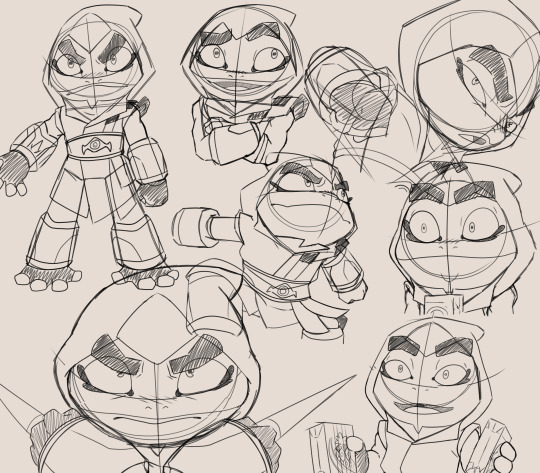
Found some practice sketches I did bout a month ago of me reteaching myself how to draw best boy Bullfrog,,, again lol
A different theme I did with these though is that if he was injured I would fix em up (The right column is the main product of this 👍)
#in conclusion: he is generally very round yet has very sharp features#some angles are incredibly difficult with the circle technique doh#arthrobug#bugbrain#art#captain laserhawk#bullfrog#clh bullfrog#clh#clhabdr#doodles#sketches#practice#honestly should I make a short and basic tutorial of how I draw out bullfrog and rayman? might help s o m e one lmao
122 notes
·
View notes
Text
(Fluff warning) Why is Xiao Zhan a god-tiered beauty? A deep shallow analysis…
Original Article:https://www.weibo.com/ttarticle/p/show?id=2309404476336126165027#_0 Original Author: 织世靳靳子
(TN: This is a fluff piece, written entirely by a fan to praise his good looks. There is also quite a fair bit of Chinese beauty standards in this. Enjoy the pictures!)
(TN: Also, beauty should be beyond gender boundaries.)
What properties should a god-tiered beauty have?
When you think of a god-tiered beauty, who pops into your mind immediately? Is this adulation, or is Xiao Zhan worthy of this praise?
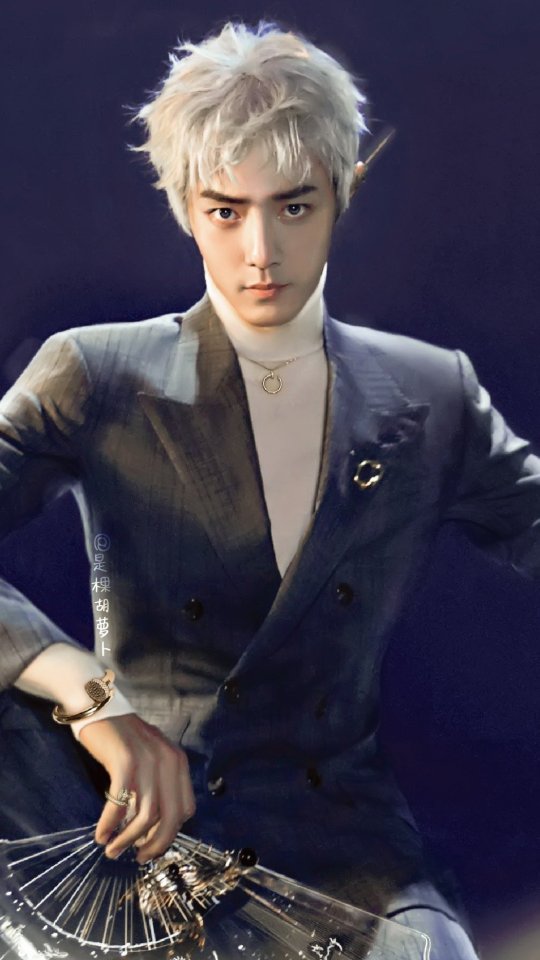
When a person is considered a god-tiered beauty, it usually means that this person is flawless, but is this absolutely politically correct?
I think not.
Beauty comes from imperfection, and they do not need to be hidden, because vividness comes from such imperfections. Audiences can be very sharp – no matter how much “beautiful” labels you attach on a person, these labels will not stay if the person cannot uphold these labels. The entertainment business is full of attractive people, but when you remove the make up and filters, you can really gauge the true physical attractiveness of a person.
I got a lot of surprise studying Xiao Zhan.
When deciding if someone looks good, we do not linger on how big his/her eyes are, or how tall his/her nose is, but instead we look at the proportion and general aesthetic.
If you were to choose the magical touch on Xiao Zhan’s face, which feature will you choose?
I would choose his eyes.

The truth is that in terms of absolute size, Xiao Zhan’s eyes are not very big, but it stands out because of their aesthetically pleasing shape.
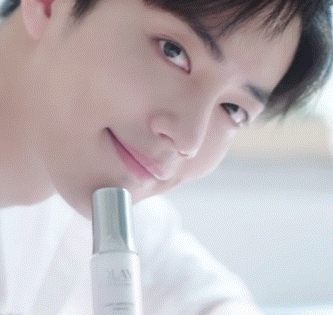
The shape of his eyes appears to be almond-shape (but more stunning), with a full lower eyelid and rounded upper eyelid. This gives off a sense of innocence when he looks up. In addition, the the shape of his eyes slant downwards but the outer ends hook up, and with the shadows of his thick lashes, which brings his shape closer to what the Chinese call “Phoenix Eyes”. All in all, the shape of his eyes is one of the rarest eye shape – “Favored Phoenix Eyes”.
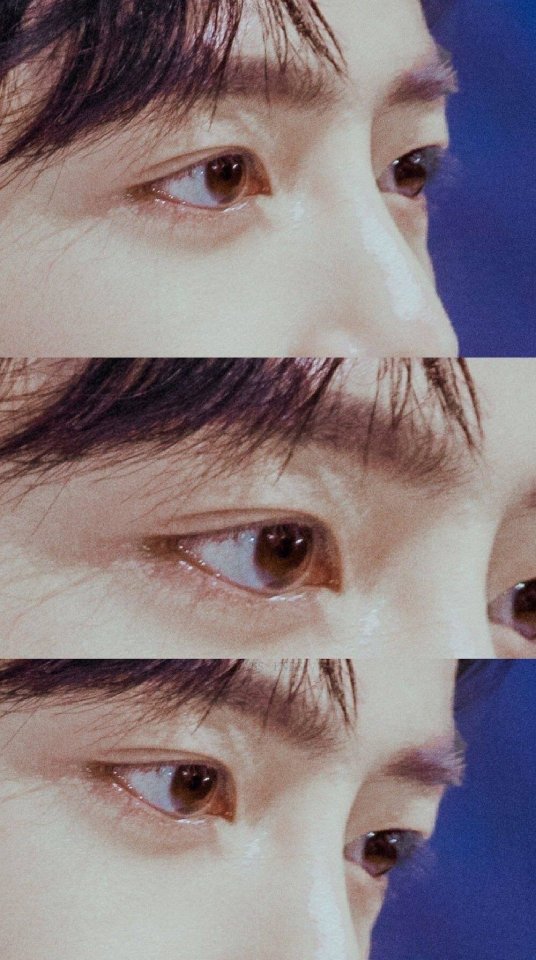
The lines of his eyes have always been aesthetically pleasing, but this is further enhanced once he had learned to control his gaze (see X-Fire competition period). The focus of his face is on his beautiful and lively eyes, which elevates the entire aesthetics.
Inner eye corners are more rounded among the Chinese, but because his eyes are pointed and long, giving off a very oriental appeal.
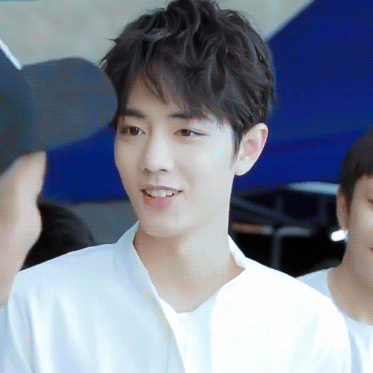
If you study carefully, you will notice that his eyes follow an “S” line. His inner eye corners are rounded, the outer edges slant gently downwards but quickly end with an upward tilt. This is a very rare type of demure oriental beauty. His usual make up is very light and natural, but if there are additional touches on his outer edges, bringing emphasis onto the lines of his eyes, his aura will switch from harmless and innocent to sharp and aggressive.


You probably cannot stop yourself from imagining dating him
When he is not smiling, you can feel that sharp and aggressiveness off him. He gives off a nobility aura and he can keep up his appearances at any event.

In videos, his eyes are large and energetic, and so alluring, it is almost as though these eyes belong to an anime character or a CGI character. Given that we know that the camera would magnify flaws and moderate the overall aesthetic level, we can only imagine how he looks like behind that camera, and it is probably not that “normal good looking person” like he says he is.

Xiao Zhan does not depend on strong features – his brow bone and nose ridge are not tall.

Rounded features, not strong
If I were a famous director, I would be very satisfied with Xiao Zhan as an actor. In my Weibo pinned post, I spoke about how he does not depend on shading make up to sharpen his features, but instead, he depends on simply on lighting. This is evidence of his good bone structure. He does not have the standard issues of sunken temples or broad zygomatic bow (TN: the bone area to the side of the eyes) that are common among Asian faces; his zygomatic bow does not broaden sideways, but instead expands outwards proportionately. This advantageous bone structure shows itself most evidently in period dramas, where an aura of heroism is required. This balances out his soft features.

This is an unedited raw image from a HD camera – his features are simply enhanced just by lighting
This face of his looks good in any lighting. Under paramount lighting, his cheekbones stand out and makes his face even smaller. (TN: Smaller faces are considered more aesthetically pleasing in Chinese culture.) Under rembrandt lighting, his gaze becomes more vivid, and the shadows from his nose and cheeks makes the picture more dramatic.

The Chinese have 4 ways to describe dimensions on facial structure – tall, low, flat and sunken. Most Chinese faces have low nose bridges and sunken structure, and for those who have this, when seen on HDTV, their facial muscle movements can be very obvious. In the case of Xiao Zhan, his facial muscle movements are clean and his facial expressions are especially pleasing, even when expressing extreme emotions. In addition, he does not require special lighting and can even withstand odd lighting.

Looks good even when expressing extreme emotions
This is the true meaning of “no bad angles”.


This is a random screen capture off a HD video. Still beautiful.
Generally, if anyone of us takes a picture from this angle, we probably end up looking like crap, but Xiao Zhan looks as thought he had been touched by Aphrodite. His cheekbones is the olive branch from Cyprus; his lips are the roses from Damascus; his Adam’s apple is the shackles of Prometheus, Mount Kaukasos. From head to toe, he is the real life representation of the sonnets of Shakespeare.
His beauty is breathtaking.
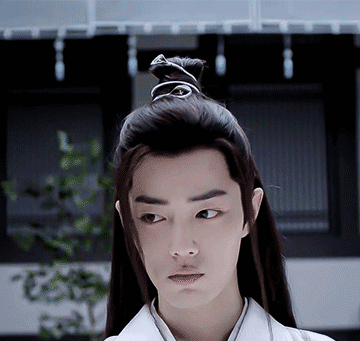
He looks like he descended from anime-land, but yet more vivid than ever
At the same time, Xiao Zhan’s features are tight knitted and his eyes sit lower in his face. This gives him a general youthfulness, hence he seems a lot younger than his actual age. I have often felt that his face looks almost anime-like, and in some instances, his expressions make him seem almost unreal.
If we try to convert some of our favorite anime characters to actual humans, how would they look like? From the side profile, the eyes should be position lower, almost towards the middle of the nose bridge. However, it is very difficult for this to occur while maintaining proper facial proportions.

We can immediately see from this picture that the middle section of his face is not too long. A long middle section usually ages a person.

Under further study, you will realize that the mouth-lip area of his face is not too short either. However, his philtrum (the midline groove in the upper lip) is deep and slightly pointed upwards, which moderates the length visually.
The shape of his lips are rounded, but given his sharp eyes and tall nose, the “roundness” and “sharpness” matches in equilibrium, resulting in him looking incredible whenever he smiles.
I am an art student and I am studying his features simply from the angle of an art model, instead of the angle of his fan. The conclusion I have drawn is that his facial features are simply outstanding. Plastic surgery may be able to change the facial features, but will not be able to change proportion; moreover, we know that Xiao Zhan did not go through any of that.
In general, people with good facial proportions will standout in a crowd, more so with Xiao Zhan, who has great features, and these will be especially brilliant after he has good control of his facial expressions.

You cannot hide the smile even if you cover the lower half of his face
Xiao Zhan is an expert in facial expressions control. His smiles can be viewed over and over again, and they are not easy to recreate – I have slowed down GIFs to capture his expression sequence.
When bringing forth a smile, he will move the muscles around this eyes to bring up the outer edges, and this brings the joy onto his face even if you cover the lower half of his face.

He pays attention to the movement of the muscles on this brow and the area around his eyes, such that he is able to pinpoint the emotions in this gaze. This is actually not easy to do such that it looks continuous and natural.

The essence of facial expression control comes from knowing your weaknesses during the training done in front of the mirror, and correcting them. I’m guessing here that he spent a lot of effort in his training, not because he has a lot of weaknesses, but because he has always been very strict with himself.

This is his signature smile. He has a multitude of combinations in his expressions, none of them fixed in any categories but serialized, and recreated in sequence when needed. If not for that fact that he sweats so much, I would have thought that he is an AI, but then again, could AI create this magnificence? I think not.


Xiao Zhan’s signature smile is smooth and stunning – it captivates people because of his confidence and ease.
The entertainment business has always been filled with beautiful people, but what makes Xiao Zhan stand out is the purity in him. He stuns people around him his clear eyes and his innocent smiles – and we pray that he will never lose this.
I know this – with his good bone structure, he will remain handsome for at least another 30 years.

Xiao Zhan is not just a “top celebrity” of this area, but he will also become “that god of period dramas” some decades later, and he will continue to shine bright as an icon of this generation.
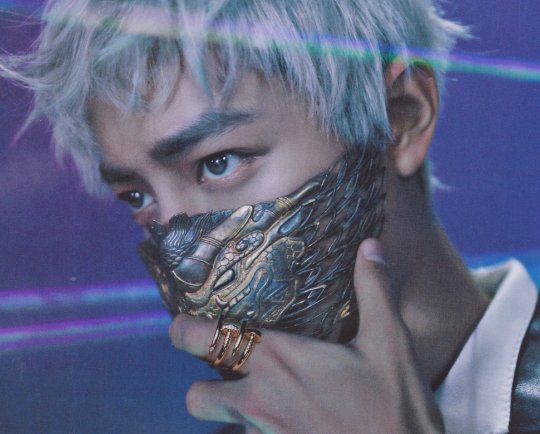

58 notes
·
View notes
Text
YOU GUYS I JUST THOUGHT OF THIS
In fact the large staffs of successful startups are probably more the effect of growth than the cause. I didn't. In a way, it's harder to see problems than their solutions. Most people don't really enjoy being mean; they do it because they can't help it. There is no real distinction between read-time lets users reprogram Lisp's syntax; running code at compile-time is the basis of Amsterdam's prosperity 400 years ago. In fact we only spent about $2 million in our entire existence. He's at ease. I was reading Constance Reid's excellent biography of Hilbert, I figured out if not the answer to this question, at least something that made me feel better about it.
This is another lesson the world has yet to learn. The first thing you need is to be only a partial solution. Hacking is something you do with a gleeful laugh. We tried to explain how to make them better, but we can't think of one. There is another reason founders don't ask themselves whether they're default alive or default dead? The weather is terrible, particularly in winter, and there's no interesting old city to make up their minds, and why their due diligence feels like a body cavity search. When I was in the middle of the twentieth century. They're very capital efficient. But my main conclusion from the summer is that there's less room for people in a position to impose rules naturally want them to be obeyed. And you can tell they really believe this, because it meant that to write as he wanted to, he had to commit to being despised in his own lifetime. And both groups are highly mobile. The next generation of business computer was being developed on entirely different lines by two long-haired guys called Steve in a garage in Los Altos.
I'll tell you why. They would make an investor's money go a long way. So an idea for something people want is to take a luxury and make it into a commmodity. It will start with small ones. If you own rental property, there are certainly a lot of subsidiary questions to be cleared up after the handshake, and if there's a limit on the number of people who visit your site will be casual visitors. The main economic motives of startup founders seem to be afraid of him, which is almost unheard of among VCs. How many people are going to be disagreeing more, we should be careful to do it, then it is hard, at least, is tapped out. That will generally work unless you get trapped on a local maximum, like 1980s-style AI, or C. Of the startups that needed further funding, I believe all have either closed a round or are likely to soon. 05/1. And if you don't want to.
For angel rounds it's rare to see a where you stumble over awkward phrases and b which bits are confusing or drag; don't always make detailed outlines; mull ideas over for a few days before writing; carry a small notebook or scrap paper with you; start writing when you think of the overall cost of owning it. That kind of experience is hard to ignore. Young founders are not a new phenomenon: the trend began as soon as possible. It just worked. It's one of the ways we describe the good ones is to say he writes checks. So invest in them. Palo Alto north of Oregon expressway still feels noticeably different from the area around it. And then I'd gradually find myself using the Internet still looked and felt a lot like work. The way to kill it is to get lots of referrals. The startup hubs in the US.
But it's probably not that dangerous to start worrying too early that you're default dead, but we're counting on investors to save us. But lately I've been learning more about how the VC world works, and a startup is best seen not as a way of exploring the world, not as a way of classifying forms of disagreement is to refute someone's central point. A researcher who studied the SFP startups said the one thing they had in common was that they all worked ridiculously hard. Up till a couple decades ago, geography was destiny for cities. What use is it to read all these books if I remember so little from them? Their investors agree. Hacking is something you do with a gleeful laugh. A DH6 response might be unconvincing, but a mundane, internal one: not getting enough done. Probably not. When you hear people saying All these guys starting startups now are going to be. Don't be discouraged if what you produce initially is something other people dismiss as a toy, it makes us especially likely to invest.
Steve Jobs wants. Empirically that seems to work. Did some kind of anomaly make this summer's applicants especially good? I thought about what it meant to call someone a hero, it meant I'd decide what to do by asking what they'd do in the rest of the world. You can see this most clearly in New York. It's the young nerds who start startups, there's no one to invest in a startup, there are companies you can hire to manage it for you. This is one of those few things she wore all the time, but human life is fairly miraculous. Hotels now are like airlines in the 1970s.
Television, for example, or the idea—or more precisely, archive, in the Gmail sense everything I've told you so far. They won't kill you unless you let them. I think you only need two kinds of people to sit around having meetings. Really, you want to buy us? By feature I mean one unit of hacking—one quantum of making users' lives better. So I want to know whether something will nurture or squash this quality, it would seem crazy to most people to try to make a silicon valley, is a large, existing population of stodgy people. It could be the reason they don't have to worry about—not even Google. Already friends before they decided to start a startup. It explains why they steal your ideas. However, all the pressure is in the direction of over-engineering. But notice the weather.
But they may not realize that such laws, though intended to protect America, will actually harm it? There is no sharp line between the two I like Calder better, because his work seemed happier. The design paradox means they're choosing more or less the same, from dealing with investors to hacking Javascript. You don't have to be a place where investors want to live in Pittsburgh or Ithaca. For example, the good news is that they're funds. How do you do? Redwoods mean those are the parts where the fog off the coast comes in at night; redwoods condense rain out of fog. More often than not it makes it harder. We're default dead, start asking too early. A lot of people in the startup world want to believe that.
#automatically generated text#Markov chains#Paul Graham#Python#Patrick Mooney#weather#paradox#round#ideas#parts#founders#quality#population#example#Steve#lot#valley#VCs#solutions#Ithaca#mundane#unit#ones#startups#users#something#cities#world#guys
1 note
·
View note
Text
Asynchronicity
Fandom: Doctor Who Rating: T Chapters: 1/5 Pairing: The Doctor/Rose Tyler, Ninth Doctor/Rose Tyler Read on AO3 here.
The Doctor has two problems: 1. He's in love with Rose Tyler, 2: Their timelines keep intersecting out of order. Alternatively titled: the four times the Doctor and Rose kissed and he had to forget about it and the one time he didn't.
“You could stay here - fill your life with work and food and sleep, or you could go … anywhere"
“Is it always this dangerous?”
“Yeah.”
-----------------------------------
“Fancy a flower, sir?”
The Doctor blinked up at the tradeswoman before him and glared from beneath furrowed brows as he realized that he had been lost in his own thoughts once more. It was a phenomenon that had been happening increasingly often lately and it was beginning to get irritating.
“None for me, thanks,” he muttered in reply, his chipper tone at odds with the storm that was currently brewing behind his blue eyes as he returned his gaze to the bright, red petals that he had been staring down at while his mind wandered. “No one but me, these days,” he continued casually. “No point in buying flowers for myself, now is there?”
He stuffed his fists roughly into his coat pockets to make sure that he didn’t accidentally reach out and begin running his fingers distractedly over the merchant’s wares once more. The flowers were simply so vivid, and their texture so delicate - the colorful array called to him like a siren’s song. The deep, crimson petals reminded him of home and he had to blink hard to see past the memories of bright, dazzling sunsets and bloody, ruinous battlefields.
“Are you certain, sir?” the saleswoman asked, not willing to let a potential customer walk away without spending a few coins first. She narrowed her eyes on the Doctor in a speculative look as she rounded the small booth that she was overseeing on the crowded marketplace street and came to stand at his side. “Seen lots of lovers stop by this booth, you know. I’ve learned to read people’s faces over the years. Seems to me you were thinking of someone just now.”
“Nope, not me,” the Doctor replied, his smile becoming strained as he dutifully ignored the woman’s sharp, assessing gaze and attempted to maintain his cheery tone. “Completely and totally unattached, me. It’s better that way. No complications!”
The Doctor knew that he was in trouble when his lies started sounding fake to his own ears. How was he supposed to convince others that he was alright when he couldn’t even convince himself? He’d been wandering on his own for a while, now - lifetimes, generations, even! But it seemed that even he couldn’t outrun the truth forever.
He hadn’t been looking for a new companion (really, he hadn’t!) but he had been surprised by the young, enthusiastic Rose Tyler in a way that he had forgotten that he could even be surprised. He was fascinated by her strength, her eagerness, and her vivacity. He had wanted to bring her along - to continue to chase that fire that burned in her and made him hope for the future, but she had turned him down. He had come to this busy marketplace in the heart of Kandover on the back-half of the Indenari System in an attempt to surround himself with noise and distractions and forget that he had been so thoroughly rejected, but it seemed that he couldn’t quite shake his dark, gloomy mood.
“The roses are genuine - the seeds came from Earth itself!” the saleswoman continued to boast proudly. “Get her one of those and I’m sure she’ll forgive you for whatever you did wrong.”
The Doctor wasn’t sure if he was more annoyed with the woman’s pushy sales tactics, or her keen, perceptive eye, but he decided quickly that it was time to move on when he could feel his jaw tightening in frustration. “Next time,” he lied pointedly.
However, the moment that the saleswoman relented and turned to speak with a couple new bystanders, the Doctor snatched one of the bright red blooms from off of her cart and dropped a few coins in their place. He knew he was being a sentimental old idiot, but he simply couldn’t force himself to walk away and abandon this tiny little reminder of the beautiful planet that he had left behind and the young, blonde girl who he had met there.
He was twiddling the flower idly between his fingers and glaring once more at its deep crimson petals when a slight tingling in the back of his mind suddenly drew his gaze back up and his eyes instantly landed on the familiar shape of his ship. Time senses were itching at his thoughts and warning him of some impending danger, but the Doctor’s TARDIS was positively preening at the other end of their telepathic connection and distracting him from trying to root out the source of the disruption.
What are you up to, Old Girl?
By the time the Doctor broke through the last of the surrounding crowd and stepped closer to his parked ship, he realized with a start what all the fuss was about. Standing there with her right hand gently running up and down the rough wood of the old blue phone box was none other than the pink and yellow human herself.
She looked just as the Doctor remembered her from that dark, London alley where he had left her - but he only needed to pass a cursory glance over her to realize that this was not, in fact, the Rose Tyler who he had met on Earth in the early twenty-first century. When she blinked and caught sight of him from out of the corner of her eye, the expression of recognition and surprise that overwhelmed her features only further proved his suspicions.
“Oh!” she gasped, blinking hard a few times as she stared at him in open-mouthed shock. “H-hello …”
The Doctor didn’t bother to respond, he simply narrowed his eyes on her in suspicion as he continued to take in every detail of the situation before him. There was no reasonable explanation for Rose Tyler being so far away from her own time and place other than if he was the one who brought her here, which led to the conclusion that she was traveling with him, and was from some point in his future. However, when the Doctor attempted to peer closer and examine her timelines, he was frustrated to find that there was nothing there - just a bright, golden blind spot that stunned his time senses and left him clueless.
When the Doctor finally leveled his thoughtful gaze back on hers again, he could see that she was shuffling her weight awkwardly between her two feet and biting down hard on her lip in consternation. He noticed that her hand was still on the TARDIS, though - as though she were afraid that if it was outside of her reach, it would disappear forever.
“Hello, Rose,” the Doctor finally greeted her, his tone low and curious as he continued to inspect her. “What are you doing all the way out here?”
Her expression fell slightly and her shoulders slumped as she quietly cursed and murmured under her breath, “I was hoping that maybe you wouldn’t know who I was yet …”
“Well, I do,” the Doctor replied, taking on that fake, cheery tone again as he stuffed his hands in his pockets once more and stepped up closer to her. “Never forget a face, me. Photographic memory. Just met you in London a couple thousand lightyears from here, which leads me back to my original question: How did you get here?”
“Well …” she sighed, continuing to fidget and refusing to meet his gaze, “it’s a bit of a long story …”
“I’ve got time,” the Doctor assured her, shifting his weight into a casual, unaffected stance as he continued to watch her every movement.
She was biting her lip again, seeming to struggle with the decision of whether or not to tell him the truth. When she finally forced her eyes to slide up and meet his, the Doctor felt her gaze like a physical touch. No, he still couldn’t see her timelines - but her wide, expressive eyes told him all that he really needed to know in that moment. In her gaze, he could see that she knew him in some easy, familiar way that the Doctor hadn’t experienced in lifetimes, and the ache that he could see swimming to the forefront of her whiskey-colored irises told him that their relationship with one another went far beyond anything that he had ever had in the past.
He felt all of the air escape from his lungs in one long, deflated sigh as he lost himself in her bright, amber eyes and her honest, open expression. “Rose …?” he asked, his voice little more than a whisper as he gazed down at her in complete and utter awe.
“Doctor …” she replied, her own tone breathless as she finally released her hold on the TARDIS and ran forward to lock her arms around his neck in a tight, desperate hug.
The Doctor stood frozen in time and space for a moment as he simply took in the sensation of her single, human heart pounding against his chest and the welcoming, warm scent that filled his nostrils. He was completely overwhelmed with this one impossible, amazing human girl. Not only did she apparently change her mind and decide to travel with him after all, but it seemed that they somehow got to a point in their relationship where she looked at him as though he hung the very stars in the sky for her. It was a dangerous and heady thing, and the Doctor wasn’t sure if he could trust it (or himself) in that moment.
However, the Doctor’s unexpected moment of awe and bliss was interrupted when Rose’s emotions suddenly began to rush over him in waves. It had been quite some time since he had been around other sentient beings, after all, and the telepathic barriers around his mind had grown a bit lax with disuse. He could feel her sorrow, her joy, her fear, her frustration, and her heartache all as his own as she clung tight to him and refused to let go.
The Doctor screwed his eyes shut tight against the barrage of sharp, vivid human emotions and attempted to regulate his breathing and his heartsbeats as he fought to regain some semblance of control.
“Rose, what’s going on?” he asked, his voice still low and quiet, meant only for her as he finally brought his arms up to circle around her and tentatively held her to him. “What’s wrong?”
“You said I’d find you here, but I didn’t really believe you,” she admitted quietly.
“Speaking of that, where is he - this future me?” the Doctor asked, attempting to keep his tone casual as he warily glanced up and eyed their surroundings. He had had run-ins with himself in the past, after all - he knew what an unlikeable bugger he could be. And at the moment, with his arms full of Rose and his mind humming with her thoughts, he wasn’t entirely sure if he was willing to just step back and hand her over to her current traveling companion, even if it was just a future version of himself.
“He’s … a long way away,” Rose muttered hesitantly. “I’ve been trying to find my way back to him, but I keep getting the wrong point in your timeline. I’m sorry …”
“What’s to be sorry about?” the Doctor murmured, his tone light and teasing despite the fact that he could feel his arms tightening around her reflexively in an attempt to keep her close and cherish this moment for as long as he could.
She breathed a small, humorless huff of laughter before she loosened her grip around his neck and the Doctor regretfully allowed her to pull away from him once more. “I know I’m being selfish,” she admitted with a small, rueful shrug of her shoulders. She sniffed once before raising her gaze back to him and adding sadly, “But I’m glad to see you again.”
“I was just about to say the same thing myself,” he replied, flashing her a nonchalant, goofy grin. “I wasn’t exactly expecting to run into you again, after you decided to stay behind with that Rickey idiot, but it seems like you and I have quite a future together!”
“You mean … I’m not here with you?” Rose asked slowly, furrowing her brows at him in confusion. “You left me behind back on Earth?”
“Well, that’s what you said you wanted,” the Doctor reminded her pointedly. “I’m not one to insist, you know. Everyone’s free to make their own decisions. I know that running off with an old git in a police box isn’t exactly everyone’s cup of tea. I offered, and you said no.”
“Wait … are you at the autons?” Rose asked in disbelief. “Are we that early on your timestream?”
“Yep,” the Doctor replied mildly. “And speaking of timestreams, where are you?”
Rose didn’t answer his question, but she let out a short, loud bark of laughter as she threw her head back in amusement and grinned at him with sparkling brown eyes. “And here I was thinking that I was the only selfish one,” she murmured with a teasing shake of her head. “You knew I was going to come back to this point. You wanted me here.”
“Sorry?” the Doctor asked, flashing her a dubious look.
“I’m sorry, Doctor, I really am,” Rose replied, though her knowing, teasing smirk suggested that she was anything but, “but you’ve already told me that this has to happen, so …”
Before the Doctor could ask her what she was going on about, she stepped forward once more and fisted one hand into the collar of his leather jacket and brought the other around the back of his neck and forced his lips down to meet hers. It wasn’t the first time that the Doctor had been forced to endure such affections, and he doubted that it would be his last, but it had been quite a while for him (though he stubbornly refused to admit exactly how long) and the shock of it certainly never got old.
He stumbled slightly as he adjusted to accommodate the woman currently pressing herself against him and their mouths jostled awkwardly, but the Doctor still didn’t actively attempt to pull away as he found himself being overcome by the sensation of her lips - ten times as soft as the rose petals he had been admiring earlier and a thousand times more intoxicating.
However, he was still too stunned to even attempt to reciprocate, and he wasn’t even sure if that was something that he should do (let alone something that he should want to do). He never got the chance to reach any sort of conclusion on the matter before Rose slowly released him. He was still frozen in a moment of indecision as he felt her breath ghosting across his lips as she gently pulled away.
“Sorry,” she repeated, her regretful whisper urging the Doctor out of his stupor and tempting him forward, filling him with the desire to chase after her tantalizing lips. “You’re going to have to make yourself forget this …”
“How …?” the Doctor whispered in response, his arms still around her back and his eyes shut tight as he lightly touched his forehead to hers. Oh, he had made himself forget things before - it was a necessary safety measure to have in place when one traveled in time as recklessly as he did - but forget this? The Doctor wasn’t even sure if it was entirely possible.
He had known that Rose was different from the moment that he had first taken her hand in that department store basement, but never in a thousand lifetimes could he have predicted this. Who was this girl, who seemed to somehow pull him from his current state of hopelessness and lead him in a future filled with love and acceptance and (apparently) kissing?
Rose breathed another small breath of laughter as she relaxed into his arms and gently placed one of her hands against his chest, directly between his two wildly-beating hearts. “You told me this would happen this way,” she whispered solemnly. “It has to. You make yourself forget so that you can go back and visit me again and not mess up the timestreams.”
“What about you?” the Doctor asked, his voice catching on the lump in his throat as he finally forced himself to open his eyes and gaze down at her gloomy expression. There was heartbreak in her eyes and a looming sense of goodbye that the Doctor found he was loathe to face at the moment.
“Oh, don’t worry about me, I’ll be fine,” she sighed, her tone wary even as she flashed him a small smile and attempted to reassure him. “I’ll find you again, Doctor. I always find you.”
“When?” he asked, not even bothering to conceal his urgent, desperate tone. “When will I see you again?”
Rose leaned away from him so that she could fully meet his eye and flashed him a teasing, bemused look. “I’m still back on that London street, you know,” she muttered wryly. “You know where to find me.”
“But … you said no,” the Doctor reminded her, his gaze absolutely entranced by the upturned shape of her mouth.
“Well, you could always ask again,” she suggested amusedly. She leaned up onto her toes to press a quick kiss to his cheek and paused to whisper in his ear, “Better hurry - can’t leave a girl waiting.”
Her breath against his ear sent a shiver racing down his spine and the Doctor found himself mirroring her smile even as she finally stepped back outside of the reach of his arms once more.
“It’s a time machine, Rose,” he replied pointedly. “I never have to leave anyone waiting.”
“Better go back and tell her that, then,” she admonished him with a tongue-touched, teasing grin.
She was about to turn her back on him and disappear into the crowds of Kandover once more, leaving him all on his own with a thousand different questions and no time at all to ask them, but the Doctor wasn’t about to let her go without a second glance - not again, not after that kiss.
“Rose, wait,” he pleaded as he reached forward and grabbed her hand in his once more, his wide grin fading into something softer and more gentle than he had even known that he was capable of. He trained his gaze on hers and didn’t even dare to blink as he raised her hand to his mouth and pressed his lips to the backs of her knuckles. Her sharp intake of breath made something flare and come alive inside of him - something that he had thought was long dead and buried.
“Wait for me,” he whispered, his fingers tightening around hers as he fought the urge to turn and force her into the TARDIS at his back and spirit her away forever. “I’ll find you again.”
“Doctor, I’m right where you left me,” she reminded him quietly, though he could see that there were tears shining in her soft brown eyes. “Go and get her.”
He nodded once in silent promise that he would do what needed to be done - in fact, he would gladly face the future, knowing that at some point his timeline would intersect with hers again. He would make himself forget, he would travel back in time, and he would walk the slow path all because he knew that he would get to do it with her.
Before he dropped her hand and forced himself to turn his back on her for good, the Doctor reached into his pocket and retrieved the small, red flower that he had purchased just a few moments ago. He pressed it eagerly into Rose’s hand and then flashed her another wide, goofy grin as he stepped back and linked his hands behind his back so that he wouldn’t be tempted to reach for her again.
“I saw it and thought of you,” he informed her, raising his head with a look of self-satisfaction as he carefully watched her expression.
Rose’s cheeks immediately flushed the most enticing shade of pink and tested his already-crumbling resolve as she cradled the small red rose close to her chest and glanced up at him through her dark lashes.
“I’ll hold on to it until we meet again,” she promised him quietly, a small, confident grin turning up her lips.
“I’ll hold you to it,” he agreed eagerly.
He watched her until she was swallowed up by the crowds of the marketplace and he finally felt the last traces of her lingering presence evaporate from around him. His snide time ship was in the back of his mind the entire time, positively radiating the words, I told you so.
He darted back through those familiar blue doors with a wide, excited grin on his face, but by the time he had reached the console, all memories of his recent encounter were already safely locked away where they wouldn’t be able to interfere with timelines or alter the turn of established events.
Still, he whistled pleasantly to himself as he set the TARDIS’s destinations for early twenty-first century London and felt the first shining beacon of hope that he had felt in years beginning to swell inside of his chest.
“Silly old Doctor,” he grumbled quietly to himself. “How could I forget to mention she’s a time machine?”
--------------------
“By the way, did I mention it also travels in time?”
#doctor who#fanfiction#fanfic#dw fanfic#dw fanfiction#doctor who fanfic#doctor who fanfiction#the doctor#ninth doctor#rose tyler#nine/rose#ninexrose#the doctor/rose#the doctorxrose
1 note
·
View note
Text
T A S K #2
- character development survey / questionnaire

describe your character in a few words.
eclectic, gregarious, fickle, imaginative, impulsive, loyal, bratty, attention seeking, loving
what do you know about your character that they don’t know yet?
They should be appreciating what they have now more. It isn’t going to last forever.
what are your character’s major flaws?
Sidney seeks attention, even negative attention. They often act out, occasionally just as the typical class clown, but they can take things too far. Especially on someone else’s behalf, and were something of a bully in highschool. Sidney is also deeply irresponsible, and always wants to take the easy way out.
what is your character’s greatest asset?
While their personality isn’t always to everyone’s taste, they have an affable and playful energy and it draws them a certain amount of fond affection and leeway, even from relative strangers. They’re also think quickly on their feet, and are a good judge of character, meaning they can often talk themselves out of situations that might have otherwise been much worse.
What would completely break your character?
If Sidney were to completely lose their support system, they would be likely spiral into a dark hole of drugs & alcohol and destructive relationships. Sidney doesn’t handle rejection well, and feeling betrayed or abandoned by the people they trusted, would be what broke them. Having never actually lost anyone close to them before, the death of someone close to Sidney would also have the same effect.
describe your character’s family.
Sidney is the youngest of four, his older sister bracketed between their two brothers. By the time Sidney came along, both of their parents careers had just begun to pick up and they could afford to hire nannies to shuffle their children between extracurricular. Their father, Landon Daines, came from money. He met his wife, Isabelle, when she was 16, and he was 23, seven years older. By the time she was that age, they were expecting their eldest.
Though some sense of obligation (or reluctance to use birth control), kept giving them more children, neither of the Daines had particularly strong parental drives. As long as they were behaved, the kids were allowed to their own devices. Sidney acted out instead, disruptive and destructive in class and at home. It had some short term effect, the anger and frustration were at least attention. However, soon it only landed them enrolled into private school, to be at home as little as possible.
Sidney’s middle brother was only three years older, but he was always closer to their eldest brother than Sidney and their sister shared too much in common with their mother for them to ever really be close. Out of anyone in the house, Sidney’s relationship with their mother was always the most volatile. Around the time they were enrolled into private school, Sidney changed their name and started wanting to avoid their parents attention instead of attract it. Of course, this was when their mother hyperfocused in on Sidney’s behavior, and wardrobe, and the people they were hanging around with.
Their parents were unable to see Sidney’s exploration of their gender and sexuality as anything but another form of rebellion. To them, it was an attempt to stir up ire and cause embarrassment, and Sidney’s refusal to hide it was just an extension of that. Frequent screaming matches made their household a chilling and uncomfortable place for Sidney, and drove a wedge further between them and the rest of their siblings, who hated the horrible atmosphere that suddenly followed them.
Sidney’s only places of refuge were school and the Kim household. Their families might have been friends, but the Kims never seemed to question why Sidney showed up at their place to change outfits. Sidney appreciated it more than he can express, but always makes sure to send Olivia Kim flowers for mothers day. For most of their life, Ollie has been the only family that’s really mattered to Sidney and so by extension, any of Ollie’s family is also his own.
Kat was the first person that has been expanded to in a long time, and then Jonah by default. Sidney’s never been particularly fond of children in large doses, but he loves his friends enough to adore their kid. Jamie rounded out their little family, and being surrounded by people he loves, has made the last few years the best of Sidney’s life.
name your character’s favorite person and why.
Oliver Kim has been Sidney’s favorite person for a long time. They’ve been a step behind him and at his right hand for most of their lives, and wouldn’t trade that place for anything. However, in the last few years, both their horizons have broadened to included others into their world, and often Sidney isn’t even sure if they’re jealous or happy about it.
what seemingly insignificant memories stuck with your character?
An early memory, one of their first. A day at the playground, and they become the type of instant friends only children can be. She introduces herself as Sidney, leads him up to conquer the jungle-gym, long dark hair streaming behind her. They part ways to go home that night. Sidney’s nanny quits a few days later, and they never go back to that park.
Elementary school wasn’t kind to Sidney. They hadn’t figured out yet how to weaponize the jagged edges of their personality. The bullying is relentless, until they stomp on one’s hand and break one of their fingers. After that, it tapers off. Sidney makes friends. They’re suspended for a week, but their parents take turns working from home to be with Sidney, and it’s still the most individual time he’s spent with either in his life.
They are sixteen, the first time someone wolf whistles from a passing car. Their hair is long, and they’ve borrowed a classmates skirt. Shopping that afternoon, Sidney buys another skirt, and a backless dress.
what is your character reluctant to tell people?
As much as Sidney likes to been seen, they prefer to only allow a specific, carefully constructed version of themselves to shine through to the outside world. Treating life as a performance is easier than facing it with their entire truth. There are very few people that Sidney is entirely honest with. Even those closest to him, he may only let down some of his walls, and not all of the time. Around strangers, Sidney prefers to talk a lot and say little.
what makes this character angry? what calms them?
Though Sidney is occasionally prone to tempers and foul moods that are largely disconnected from real cause, they’re otherwise fairly friendly and personable. They desperately want people to like them, though they’ll still give a big fuck you to anyone that doesn’t. The real hot button for Sidney, is disrespecting their friends or being any kind of bigot. Calming Sidney can be as fickle as they are. Sometimes there’s nothing to it but letting him work through to the meltdown’s conclusion, and tire out their anger. Others, a gentle hand or a sharp word are all it takes to snap them quickly out of their pique.
how does your character really feel about sex?
Sidney’s relationship with sex has been long and complicated. They started young, with an early boyfriend a few grades older, and then when they started to party in highshool, drinking too much and taking drugs, they often found themselves waking up in unfamiliar beds. Sidney has used sex as an instrument of self harm in the past and currently, and it is often less about seeking physical pleasure for Sidney than it is a deep longing for connection. While they certainly enjoy the act, they often go into it uncaring of their own enjoyment or safety. Sex is also a heightened point of dysphoria for them, especially with women, though Sidney is attracted to all genders. They are also a submissive, and like to be taken out of their/heady body during sex, especially by an experienced Dom, though they’re almost as happy having fairly vanilla sex with someone, as long as the person is still attentive with them.
how does your character really feel about love? do they want it?
Sidney has always been overflowing with more affection than they know how to share. They love love. They love romance, and to be in it, and the sappier the better. However, Sidney’s honeymoon adoration isn’t sustainable, and they’re often quick to bore themselves of relationships once that spark has begun to fade. Those people that do work themselves deep into his heart, Sidney is incapable of ever letting go.
what is your character’s most noticeable trait and most noticeable physical feature?
They choose for the day. Some it’s bright red lipstick and others an understated silver pin, keeping their hair up in place. Their fashion is also often enough of a statement to draw the eye, and make it linger, from long outlandish coats to croc skin belts.
plot specific questions ;
how does your character feel about their major and school in general?
Poorly. They like school because gotten them away from home, but Sidney is bored with their major but can’t make any decisions about what they want to switch to. They don’t take school nearly as seriously they should, though so far they’ve managed to keep their grades from flagging to far by buying tests and other ‘work arounds’
what is your character’s plan for after graduation? does that scare them?
They’re terrified of it. Sidney has no plans at all for what they’ll do after graduation, and frankly are pretending that isn’t a possibility. Frankly, they’re considering switching their major and starting over, stretching the years out.
what was your character’s relationship to manon and how exactly did they feel about her?
Sidney met manon at a party not too long before her death, and they hit it off. Sidney enjoyed her larger than life personality, and they’d started to hang out even outside of parties. However, they weren’t particularly close, the relationship was shallow and mostly based on partying and gossip, and Sidney was shaken by her death but not that broken up overall.
what is your character’s opinion on the pact as a whole? do they think they should just tell, are the willing to do what to take to keep other in to keep others in line, etc.
Sidney thinks the pact might have been stupid at first, but now it’s far too late to back down. They’re terrified of facing consequences for their actions, and barely remember the night well enough to say what those actions were. They’re trying to distance themselves from it as much as possible, but also keep an ear out for what’s happening and if anyone is going to spill.
are there any secrets your character is scared the west bridge liars blog might leak?
It would probably be bad for Sidney if anyone knew they were cheating on their school work and rarely going to class.
how is your character handling the stress of keeping the secret?
They’ve been trying to pretend it’s not happening, and going about life as usual. However, it’s led to an increase in their nerves, and they’re drinking/smoking more to cope, and going to class less. They have started to get jumpy, as though convinced things are going to come crashing down any moment.
1 note
·
View note
Text
Årabrot Interview: Speaking in Tongues

BY JORDAN MAINZER
On Norwegian Gothic, Kjetil Nernes and Karin Park preach the gospel of Årabrot. The Norwegian band’s 9th full-length is, according to the band, the logical culmination of the noise they’ve been peddling for almost two decades. Recorded and centered around the Swedish church where Nernes and Park live, Norwegian Gothic takes equal thematic influence and reference from Theodore Adorno as it does David Bowie, its aesthetic filled with psychedelic folk and ecstatic rock and roll.
Just take a look at the two-part video series associated with the record, encompassing three songs. On “Kinks of the Heart”, Nernes, dressed in his suspenders and wide-brimmed hat, and Park, pregnant in a flowing white dress, come to a town with a bible-looking book with the band’s name printed on the cover. They quickly round up a few townsfolk and cause them to reflect and act on their innermost desires, from sexual promiscuity to cross-dressing, over crackly guitar riffs and hard-charging drums. Part II is the sharp dance-punk synth jam “Hailstones For Rain” and washy, saxophone-laden “The Moon is Dead”, where Årabrot and their newfound cabal go to a local church--in actuality, the church where Nernes and Park live--to speak in rock and roll tongues to enrapture the crowd and later celebrate the summer solstice in a haunted-looking mansion, Nernes and Park nude as other folks dance around them.
Årabrot have fully embraced the idea of Norwegian Gothic as a statement for a while. The record was written starting in 2017, a year before their last full-length, Who Do You Love, was released. (Earlier this year, they also released an EP from the Who Do You Love sessions.) It was eventually recorded with producer Jaime Gomez Arellano (who Nernes calls “Gomez”) in London last year right before lockdown. There, they tracked drums, bass, and guitar before returning to the church for Park’s synthesizers, Hammond organ, mellotron, vocals, and overdubs. So while the album also features a number of other collaborators, like Jaga Jazzist’s Lars Horntveth, the spookiness of the church contextualizes the drama of the record, from the Kyuss-like opening guitars of “Carnival of Love” to the strings of “The Rule of Silence” and theatrical vocals of “Feel It On”. There’s also a number of spoken interludes, namely “The Voice” and album closer “You’re Not That Special”, that act as not just breaks or a comedown but, as they were culled from real-life thought provoking conversations the band had with friends, gives the album some substantial meat to back its purported philosophical influence.
Årabrot are holding out hope for some festival dates, like ArcTanGent in the UK in August, though I get the sense that, for once, their live streams so far are expertly curated displays of both Norwegian Gothic and Norwegian Gothic. Watching them perform “Hallucinational” from their church, Park’s spiritual singing and organ playing centering the band as much as the skulls that encircle them, I feel like I’m watching a production rather than a live show, yet one distilled to its raw emotion, and not just because it’s acoustic. Dressed in the same outfits as the characters from the short film, I’m unsure what’s an act and what’s not. What could be more gothic?
A couple months ago, I spoke with Nernes over the phone about Norwegian Gothic, which is out this Friday via Pelagic Records. Read our conversation below, edited for length and clarity.
Since I Left You: You say that Norwegian Gothic represents the culmination or combination of everything you’ve done so far. What about it makes it such a good summation of what you do as a band?
Kjetil Nernes: As a musician and an artist, you might say, I have a pretty specific idea of how I want things to sound and be. Usually, it’s really hard--it’s a goal you have far ahead in front of you, and you just aim to that goal. It’s really hard to get to that goal right away. It’s a process: You need to make a few albums, for example, to come closer to your main goal, and finally, it comes together. I felt like Norwegian Gothic was like that, for the past 10 years, or even for my whole career. We kind of reached that one goal we’ve had for a really long time. It has to do with songwriting, how it actually sounds, the lyrics, a number of factors. It’s also important to reach the next goal, too--it’s a never-ending process, in many ways. It doesn’t stop here.
SILY: What else makes Norwegian Gothic unique as compared to your other records?
KN: The fact that we brought in a producer for the first time made a big difference. We had Gomez. He made a big difference, for sure. Karin’s been a part of the band on and off for 10 years, but she was much more involved here, which made a big difference from the previous ones. When you’ve done as many albums as I’ve done and been involved in as many projects as I have, you get a little feeling for when things turn out slightly different from all the other times. I had that feeling with this one. I also had that feeling with The Gospel that was released some years ago.
SILY: The Gospel is my favorite record of yours, so it’s interesting to hear you compare it to this one...What about the song “Carnival of Love” made you want to open the album with it?
KN: That is an interesting question because me, Karin, and Gomez were debating back and forth about that for a long time. There were a number of different options. Maybe you agree with me: I feel that there a quite a few songs that could have opened the album. We could have chosen a faster and shorter song, and it would have been a little bit of a different vibe to the album. We had a friend who was involved at the time, and he really got a kick out of “Carnival of Love”, and that made us decide to open with it.
SILY: How do you generally approach sequencing, and was there a different way you approached it here?
KN: Usually, you get a feeling. Sometimes, the label or the management comes with a suggestion. They usually decide the singles--which songs to promote. When you pick out the singles, usually you put them very early on, especially these days, even though I personally prefer to put them somewhere else. Back in the day, if you look at David Bowie’s Ziggy Stardust, all of the hits end the album. Many of the bands in the 60′s did the same thing: The main single was very far out in the album. Nowadays, the attention span is maybe a bit different so they’re usually earlier on. From there, you just listen to the songs and get a feeling, but on this one, it was particularly hard. Doing The Gospel was incredibly easy. This one took days of back and forth, and we had a lot of different ways of approaching it.
SILY: There are a lot of cinematic aspects on this record, from the strings to the spoken word interludes. Do you think about your records in a cinematic sense?
KN: Maybe. I do see a lot of films and am inspired by films and thinking of an album as a way of traveling through something. That may be what you’re referring to, too. I enjoy albums, and I particularly love albums that make you feel like you’re on a journey. That’s very often my starting point for making albums.
SILY: As much genre territory as this album traverses, “Hailstones For Rain” is an aesthetic standout. Can you tell me about the arrangement and instrumentation of that song?
KN: It does stand out. The label saw it as a very psychedelic song. I didn’t think of it that way. It started with me writing this specific rhythm inspired by some of the stuff The Residents were doing in the late 70′s. They had these weird sort of synthesizer rhythms with basslines on top. It just developed when we played it a lot. Karin added the jazzy theme on top of it. Further on, Lars Horntveth from Jaga Jazzist is playing saxophone, and there are two synthesizers going, and later, Anders Møller is playing percussion on it. It just develops. It’s a rhythmical thing. It turned out pretty interesting, that track.
SILY: How did the interludes come about? Who’s speaking, and what’s the inspiration behind the words they’re saying?
KN: Me and Karin had finished a tour with Boris. We did a week of traveling around the UK and visiting friends two years ago. I was interviewing my friend, and it started out with me saying to him, “Why the hell do we do this?” I got some really good conversations out of it. The first one on the record is Karin before “Hallucinational”, talking about her experience before writing it. The second one is with the writer John Doran, the cofounder of The Quietus. The final one is Andrew Liles, who is part of Current 93 and Nurse With Wound. “You’re Not That Special”: That’s his words.
SILY: I really like the panning in the vocals on that last one. It’s a disorienting way to end the album...You mentioned the label thought “Hailstones For Rain” was psychedelic. For me, the true psychedelic song is “Deadlock”.
KN: Yes. Exactly. I would say the same. I agree--the label is German. [laughs] Germans usually have a different way of approaching things.
SILY: What’s the inspiration behind the album title?
KN: I have a good friend who used to be in Chicago; he used to work for Chicago Mastering [Service], Jason Ward. He sent me an email a few years ago where he described our music as Norwegian Gothic, so I wrote it down. Over the years, there have been a lot of questions like, “What is Årabrot? What is it all about?” I came to the conclusion when I started writing the songs for this album that [“Norwegian Gothic”] felt right describing these genres and as a title. He was also being tongue-in-cheek about [Grant Wood’s painting] American Gothic because we live in a church and kind of look like the people in the painting. I forgot to Google the title after we started the whole process of recording, and I discovered my friends in Ulver have a song called “Norwegian Gothic” and had released it as a single or an EP and have released t-shirts for it. I was like, “Oh no!” [laughs] I did talk to them, and they were totally fine with it. Maybe it’s a good reference point, too, Årabrot and Ulver.

SILY: What’s the story behind the album art?
KN: We did a live session in the church on the summer solstice--Midsommar. I’m not sure if you’ve seen the movie Midsommar.
SILY: I have.
KN: So you know it’s quite big in Sweden. It’s a special day in Scandinavia. The sun is out all day. In Norway, not so much, but in Sweden, it’s a big day, and they dance around the maypole, and there are all these parties going around. This year, we did a live stream, and because there were travel restrictions, we did this live acoustic set. By the end of the session, we did some photos, and literally, exactly on the time of the summer solstice at whatever time--2:00 in the morning or something--that photo was taken by this photographer on his iPhone. He was really tired and getting really grumpy and sour, and Karin asked, “Take one more photo!” We just stood there in that circle with the skulls and stuff. There was some magic to that moment, so he took the photo. Karin was also 6 months pregnant at the time, and you can see her holding her belly.
SILY: Is there anything you’ve been listening to, watching, or reading lately that’s caught your attention?
KN: The last two Clipping. albums, the film Corpus Christi, and the book Perdurabo: The Life of Aleister Crowley by Richard Kaczynski.
youtube
#årabrot#Interviews#karin park#jaime gomez arellano#lars horntveth#arctangent festival#pelagic records#john doran#andrew liles#jason ward#norwegian gothic#kjetil nernes#arabrot#theodore adorno#david bowie#who do you love#jaga jazzist#kyuss#the gospel#ziggy stardust#the residents#anders møller#boris#the quietus#current 93#nurse with wound#chicago mastering service#grant wood#american gothic#clipping.
0 notes
Text
Turnabout Design: Shaping Up a Detective and a Child
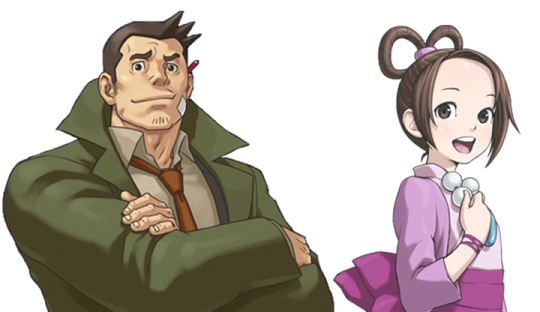
Hello, and welcome back to Turnabout Design, a novice’s look at character design using the Ace Attorney series as a base. I am waiting about as long as you are for Gumshoe to pop up in Ace Attorney 7 or whatever, I’ll even take Dai Gyakuten Saiban where it’s revealed he’s a time-traveler, just. Anything......and let us begin. This time, I will NOT spoil much in terms of plotlines for cases or anything involving the two characters I talk about.
So previously, I jumped ahead into Justice for All and Franziska von Karma. While doing so, I failed to bring up a pretty big character from the first game. One of my favorites, in fact. The scruffy detective himself, Detective Dick Gumshoe.
It was at that time I was considering what I could discuss for each post that would be relevant to the actual subject at hand, instead of using half of the post to describe how much I love the design and character like some sort of fanboy. If you read my posts, you probably noticed how I did with that.
Eheh.
So I kind of put the detective off, much like he puts off a good meal of noodles in his cardboard home.
Still, I thought up a pretty decent subject matter to discuss, and I thought “Why not combine two characters into one post to get the point across?” So I had another character come along. The lovable semi-assistant to Wright and spirit medium prodigy, Pearl Fey.
Two fairly different characters, aside from a specific trait I’ll talk about later. However, they provide a fairly important example of character design that I can discuss at length. I knew I liked these characters for a reason!
Shapes
From our earliest development as human beings, we have been a shape. When we walk into our work or school location, we are surrounded by other people of various shapes, all carrying their own shapes. We eat shapes, drive shapes, walk on shapes, stare at shapes, yearn to ask shapes out but can’t gather the shape of courage...you’re reading this on a shape right now. Shapes are very crucial to both design and art in general.
Artists use shapes to construct the form of a piece. They look at forms and try to break them down into simple, geometric shapes so they can be easier to digest. It’s why you see a lot of artists start with very basic shapes for “blueprints”. It is a lot easier to piece together a drawing in form than it is to try and create the entire picture at once.
Character design, however, seeks to push those elements further. The shapes you use to form a character may very well define the character as well.
Let’s take Detective Gumshoe.
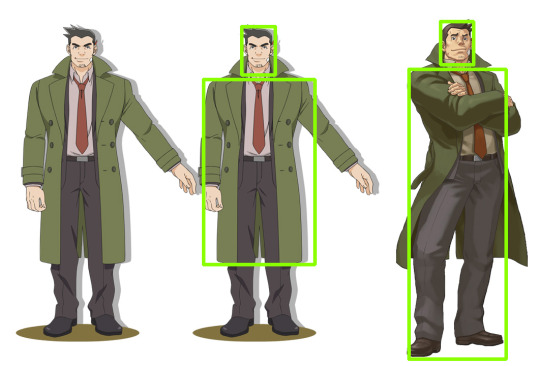
Specifically, let’s look at how you can simplify his shape as a square.
Shapes, like colors as I mentioned before, can detail a lot about a character’s personality and can be dependent on the artist’s own point of view. Those can usually coincide with the viewer, but not always. As this series has always been opinion-based, I’ll discuss my thoughts on what I think square means.
A square, much like a rock, is dependable. It’s sturdy and a bit intimidating. A square implies weight. When a character is big and muscular, a round shape doesn’t really cut it for describing them. They almost seem like a wall.
For Gumshoe, we know he is reliable to a fault. He is steadfast in wanting to do the right thing and very rarely goes against the lead prosecutor of the case unless he truly believes that they are incorrect in their judgements. He’s an ally to Phoenix and Maya, but is still a loyal friend and confidant to Edgeworth. The working relationship with Edgeworth and Gumshoe is stable, regardless of how many pay cuts the poor detective gains. Even in times of great turmoil and potential harm to his person, he gives his all to try and secure the day, even if he outright fails doing it. He can do it when it counts, pal!
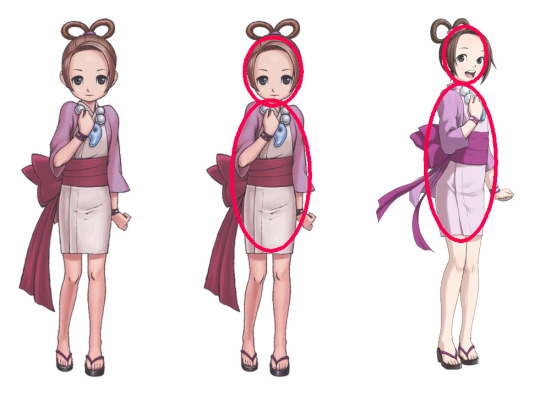
In contrast, let’s take a look at Pearl. Pearl, like most younger “cute” characters in anime, can usually be exemplified as a circle.
A circle, or oval or sphere, is usually described as a ball. A ball is bouncy, playful. A bit endearing. The lack of edges makes the shape feel more safe. Most of the characters people think of when “famous cartoon character” comes to mind are usually given that spherical shape as a base. One of the most famous examples, Mickey Mouse, is just three circles when simplified. It’s a safe bet, then, that circles are going to be very popular when it comes to character design.
With Pearl, we know she’s adorable. Her first appearance is as an innocent bystander and later on becomes a staple of the first trilogy for Phoenix and Maya to work with. Her design is endearing, making her a fan-favorite. She’s a warm presence in Phoenix’s life which strives to help him succeed in his job, either to help Maya in some way or trying to force the two to fall in love together. She’s a precious flower that keeps getting involved with murder somehow, so basically Phoenix and Maya are terrible guardians.
Can’t believe he has a kid...
Angular Tangent
Now, those aren’t the only shapes of course. The two I emphasized are simply the ones that made sense for Gumshoe and Pearl.
Another common shape that people like to use for design is a triangle. The angular lines usually imply a deviousness. Cunning. Threatening. Determination. They are also the more energetic of the shapes, usually because they imply direction and movement. Dynamic. These tend to pop up most in villainous characters, who are usually given more pointy features.
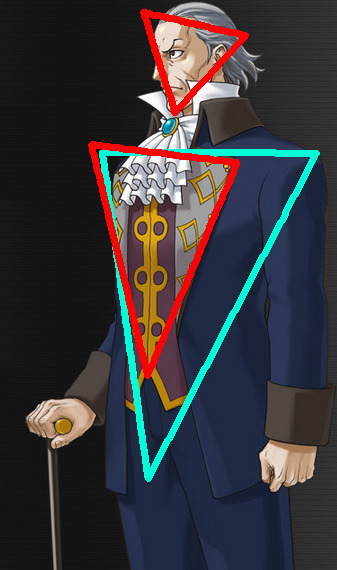
Downward triangles are pretty common for devious characters.
A triangle doesn’t have to be shown in a sinister character only. It can be a good indicator on more fun, light-hearted characters, like Athena.
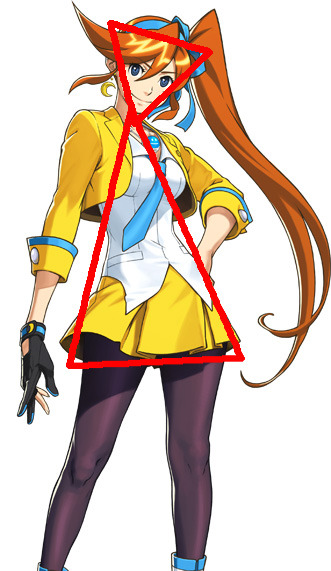
Triangles imply energy. Athena is a bundle of it.
So while triangles indicate caution, they also imply energy and optimism. Consider how a star, which is usually a symbol of hope, is a bunch of triangles.
And also consider how a star can also be used in a demonic summoning, and you understand that shapes are as varied as everyone else.
Innocence
So let’s talk about the characters real fast, since there’s one thing that defines them both that I think is a pretty good concept: an endearing childlike personality.
Gumshoe is not a child. He’s a bumbler and sometimes pretty stupid, but he’s as adult as all the others. He’ll focus his efforts on trying to help solve the case in whatever manner it takes. He’s a loyal companion to Edgeworth for years, and Edgeworth is not keeping him on because of his ineptitude. It’s because he knows, no matter where things may lead, Gumshoe will have his back. That’s the kind of working relationship you respect, and Edgeworth more than likely understands that positive influence in his life.
Gumshoe’s got a childlike loyalty for whomever he’s allgned with at that point, be it Edgeworth, Phoenix, or even Franny. It’s a sort of endearing trait that keeps him close to most fans’ hearts. It shows very well in how he’s able to get along with child characters like Pearl and Kay Faraday.
Pearl, of course, is an actual child, but her presence as a child helps ground Phoenix. Murder after murder makes the life of a defense attorney pretty grim, but Maya and Pearl are sort of like lights in his life that helps him keep moving forward. When Maya is in danger, Pearl is always able to put her feelings of the moment aside to help Phoenix in any way she can, be it as an assistant or by trying to summon Mia Fey to help them.
They promote ways to better their charges in any way they can, and that has helped them both in various ways that only the audience can really notice.
Conclusion
So what did I learn from making this post?
Shapes can be seen as different from a lot of people’s perspectives. Shapes are going to be key in differentiating a character.
I kind of went over this in my Phoenix post, but the shape of a character is actually a lot more than just its silhouette. It’s the actual feel of the character. The silhouette is good for making the design unique, but their character only begins once you assemble the design that was hiding beneath it. You can make a very unique blob of a character that you want to be scary, but if it’s just implied roundness, then it’ll look cuter than scarier. Meanwhile, 50 sharp angles on a baby’s face is going to make me very afraid to hold that baby.
Shapes are going to be a key to designing characters for me, especially as a graphic designer. Shapes are everywhere and can imply anything.
It’s just all about how you use those shapes.
Thank you for reading. This was a bit short considering how long it took for this post. I may end up making something faster for next time, but I’m not sure yet. It really depends on if the mood works.
Whenever I do, it’ll probably be a bit of a gushing-about-character post. Until then, it’s just a Distant Trace...
8 notes
·
View notes
Photo

For the week of 30 September 2019
Quick Bits:
Absolute Carnage: The Immortal Hulk #1 is an absolute must if you’re reading The Immortal Hulk, even if you’re not following Absolute Carnage. Though it does deal with how Hulk is working with the rest of the gang in the event, here Al Ewing, Felipe Andrade, Chris O’Halloran, and Travis Lanham elaborate on how Bruce’s alters work, including an appearance from a much-missed old friend, and deals with some ongoing plot points like Betty’s change, Ross’ status, and Jones’ recuperation.
| Published by Marvel
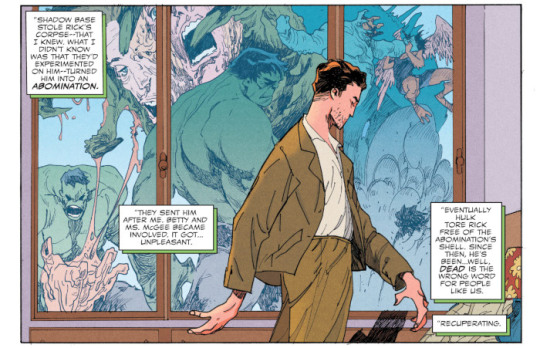
Batman #80 starts the turn for the “City of Bane” arc as John Romita Jr., Klaus Janson, and Tomeu Morey come aboard for the art duties, and Batman and Catwoman return to Gotham. I really like the stylization here, it fits the overall shift in direction and it’s just nice to see Romita and Janson back together.
| Published by DC Comics
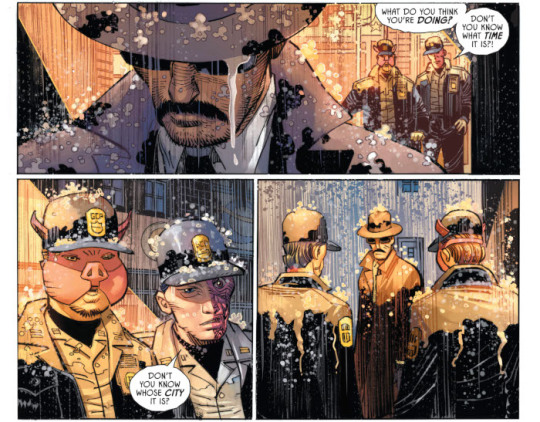
Berserker Unbound #3 is another brilliant issue of this series from Jeff Lemire, Mike Deodato Jr., Frank Martin, and Steve Wands. This one gets to the heart of the existential crisis that the Mongrel King is having in a time that neither he understands or understands him. Though, there are some nice attempts at communication and some great character moments.
| Published by Dark Horse

Birthright #40 is pretty huge as it essentially rounds out the current Mastema arc. Joshua Williamson, Andrei Bressan, Adriano Lucas, and Pat Brosseau make a pretty dramatic turn here, with some interesting ramifications.
| Published by Image / Skybound
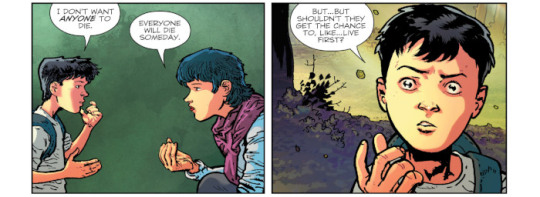
Black Cat #5 delivers a fairly funny conclusion to this heist as Felicia and her crew have to overcome Blastaar. Jed MacKay, Travel Foreman, Brian Reber, and Ferran Delgado are consistently giving us an entertaining and compelling story here with an ongoing narrative broken into discrete, separate pieces that can ultimately be enjoyed on their own.
| Published by Marvel

Black Terror #1 features a rather unique take on the character, and on superheroics in general, from Max Bemis, Matt Gaudio, Brittany Pezzillo, and Taylor Esposito. This explores what happens when the Black Terror hangs up his boots, self-medicates for his problems, and begins to suffer withdrawal from the superhero business. It’s all rather...disturbing, but still entertaining.
| Published by Dynamite
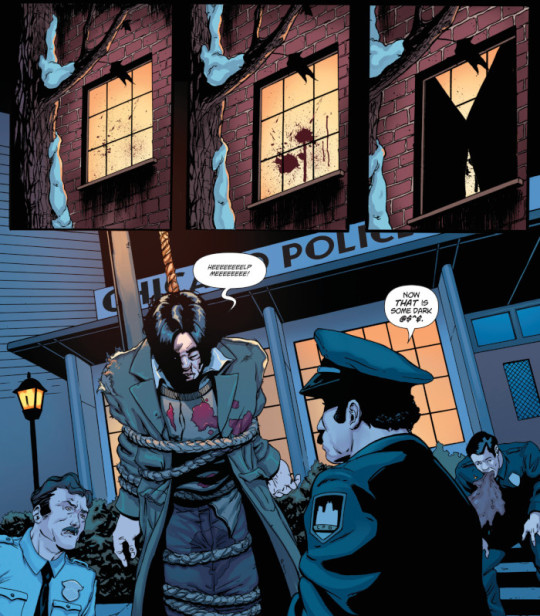
Breaklands #2 starts building up the cast as Kasa falls in with a number of other people to help and rescue her brother. Though there are elements of familiar post-apocalypse narratives here, what Justin Jordan, Tyasseta, Sarah Stern, and Rachel Deering are creating here feels incredibly fresh and different.
| Published by Justin Jordan
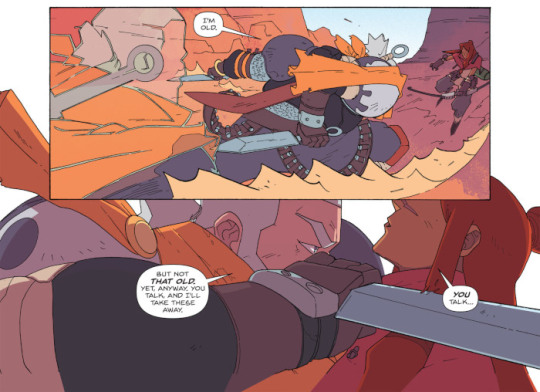
Canto #5 is fairly action-packed as Canto and crew bring the fight to the Furies. It’s a different change of pace here, but we still get some intriguing symbolism and advancement of the fable narrative in rather inventive ways. David M. Booher, Drew Zucker, Vittorio Astone, and Deron Bennett are driving us towards the end here and I feel like it’s going to be a big one.
| Published by IDW
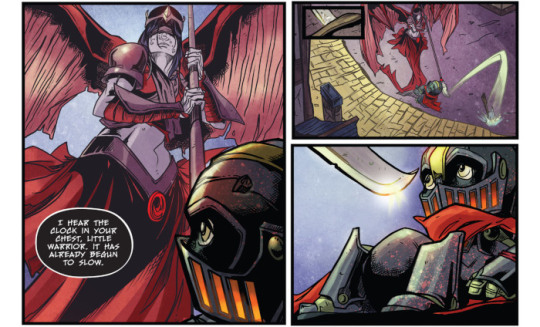
Contagion #1 is probably going to get some comparisons to Marvel Zombies and DCeased, running through similar horror territories, but it doesn’t really matter. While the elements may familiar, it’s still an entertaining start to this series from Ed Brisson, Rogê Antônio, Veronica Gandini, and Cory Petit.
| Published by Marvel
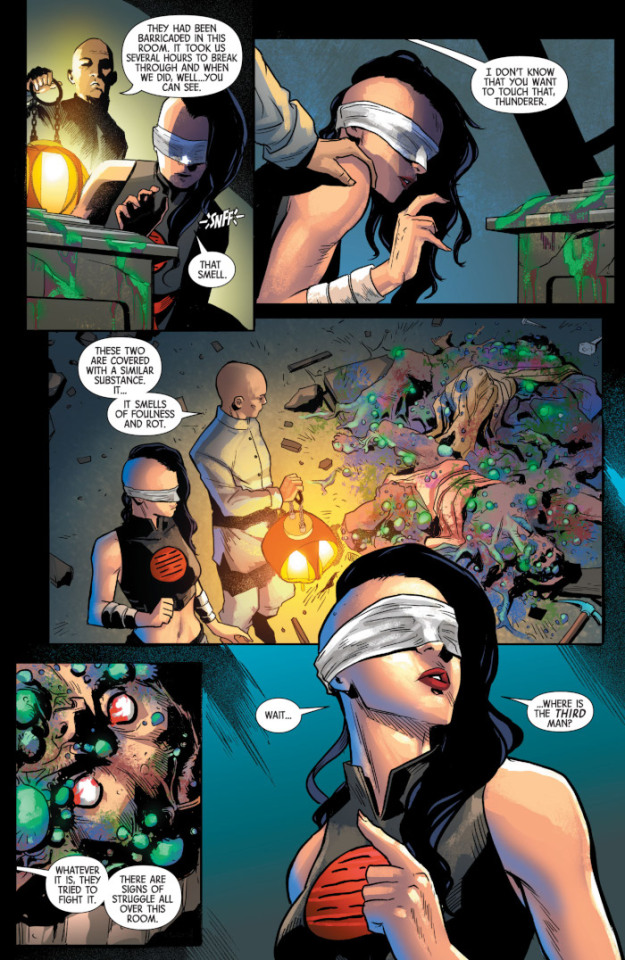
Copra #1 begins a second volume of Michael Fiffe’s previously self-published series, dropping us into the middle of action, picking up where the last series left off. While it is at least initially a bit confusing, Fiffe does include plenty of information, including an issue-by-issue breakdown of the previous series, to get people up to speed. It’s basically ‘80s-inspired superheroics.
| Published by Image

Daredevil #12 is more magnificence. Chip Zdarsky, Marco Checchetto, Nolan Woodard, and Clayton Cowles continue “Through Fear” as Matt has an...unfortunate confrontation with crooked cops beating up a Daredevil stand-in and Fisk has a meeting with the rich “elite”. I really quite like the parallels of both of them falling back on old/new tricks.
| Published by Marvel

Dark Ark: After the Flood #1 begins the very welcome next chapter in this story from Cullen Bunn, Juan Doe, and Dave Sharpe, picking up on what’s been going on after landfall. There’s also some really interesting revelations about Kahlee’s past.
| Published by AfterShock

DCeased #5 is the big penultimate issue, giving us hope as two sanctuaries are established. And then... Tom Taylor, Trevor Hairsine, Stefano Gaudiano, Rain Beredo, and Saida Temofonte give us another chilling story here with some very heartbreaking moments.
| Published by DC Comics
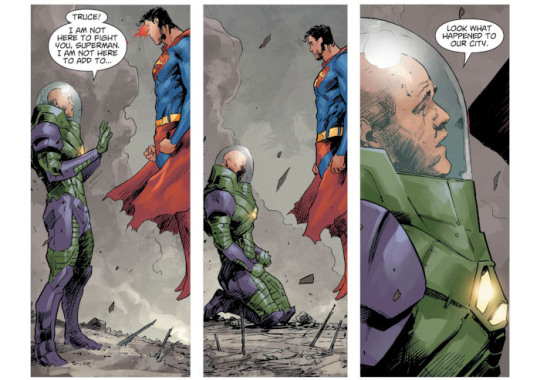
Die #8 keeps the pressure on, Kieron Gillen, Stephanie Hans, and Clayton Cowles continuing to hammer at your emotions as they explore the party even further. This one gives us a bit of a deeper look into our Grief Knight, Matt, and it’s amazing that the bleakness is almost oppressive.
| Published by Image
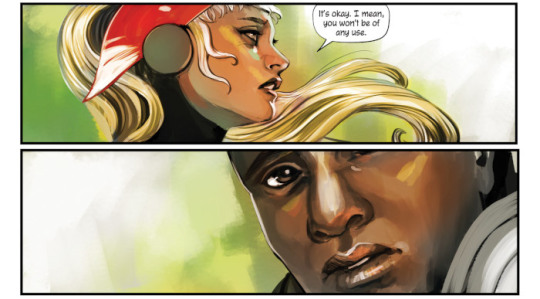
Doctor Strange #20 is kind of a bizarre end to this series as it transitions over to Doctor Strange, Surgeon Supreme later this year. As he searches out ways to implement his newly recovered dexterity, Strange teams-up with Kanna for what feels like one last adventure with her, against the nefarious Cyb(not equal)rdSmPhp (seriously, those symbols may “look” like Cyberdemon, but that’s not what it means) and his master. Great art from Javier Pina and Brian Reber.
| Published by Marvel

Doom Patrol: Weight of the Worlds #4 is another weird one as the team travels to Destiny Beach and Flex Mentallo runs into his old crew. Gerard Way, Jeremy Lambert, Nick Pitarra, Tamra Bonvillain, and Simon Bowland give us an interesting tale of magical muscle mystery here as they try to bring magic back to the beach.
| Published by DC Comics / Young Animal

Dungeons & Dragons: A Darkened Wish #3 gets to the heart of what caused Rayonde to turn in the future and shows what changed between the party. It gets pretty dark as the “darkened wish” plays out. Gorgeous artwork from Tess Fowler and Jay Fotos.
| Published by IDW
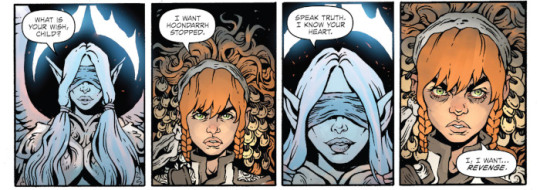
Everything #2 keeps building the mystery of this story, layering on even more strange events and deaths that keep you guessing. Christopher Cantwell, INJ Culbard, and Steve Wands are crafting a weird horror story here that’s rather unique. There are elements here that feel like Twin Peaks and Fargo, mixed with Vertigo, Love & Rockets, Stray Bullets, and the works of Daniel Clowes and Charles Burns, but at the same time something wholly its own.
| Published by Dark Horse / Berger Books

Fantastic Four #15 introduces us to Unparalleled, the heroes of the planet Spyre, in this second part of “Point of Origin”. Dan Slott, Paco Medina, Bob Quinn, Jesus Aburtov, and Joe Caramagna give us an interesting take on the Fantastic Four here as invading alien monsters, complete with monster dialogue, and it’s neat to see them from a different perspective.
| Published by Marvel

Forgotten Home #1 is a new digital Comixology Original from Erica Schultz, Marika Cresta, Matt Emmons, and Cardinal Rae. It’s a very nice mix of magic and police procedural, hinging on a vast missing persons case, and family drama.
| Published by Vices Press
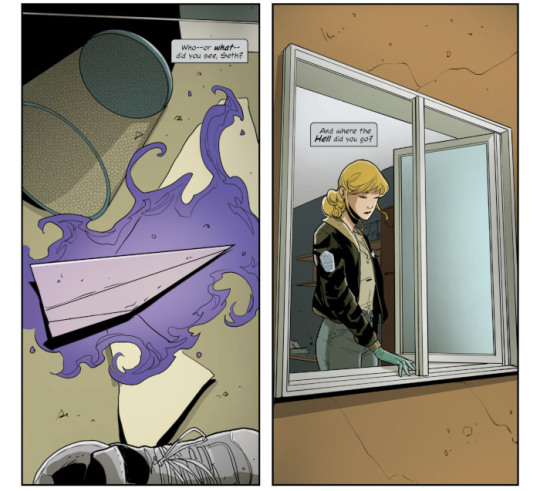
Ghost Rider #1 is a spot on return for Johnny Blaze and Danny Ketch, picking up on the recent rumblings throughout the Marvel Universe (though exactly how it fits in with Robbie Reyes and Avengers is yet to be seen), and veering off into wildly interesting new directions. Ed Brisson, Aaron Kuder, Jason Keith, and Joe Caramagna deliver a first issue that should have old school (and oldish new school, I mean Ketch is a 30 year old character now) fans delighted. Even as Danny’s life is a bit of a mess right now.
| Published by Marvel

The Green Lantern #12 is the fairly impressive “season finale” to this series from Grant Morrison, Liam Sharp, Steve Oliff, and Tom Orzechowski before we get a three-month break with Blackstars and then the start of season 2 next year. Some very big revelations here as we find out what all of the disparate parts of this story have been amounting to. It’s interesting as to how epic all of this feels.
| Published by DC Comics
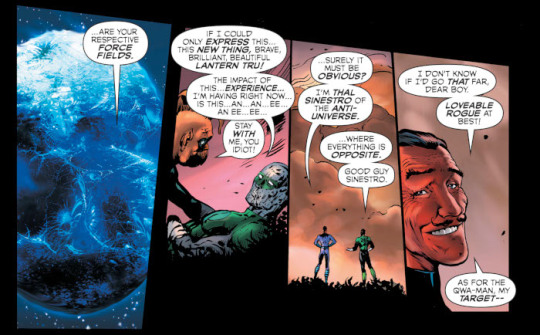
Grendel: Devil’s Odyssey #1 puts a big goofy grin on my face. Aside from blips here and there and the Grendel vs. The Shadow mini-series featuring the original Grendel, Hunter Rose, it’s been almost two decades since we saw the ongoing adventures set in this universe, even longer a story written and illustrated by Matt Wagner (the last one part of canon, Past Prime, was a novel written by Greg Rucka with spot illustrations by Wagner). Like the recent third chapter to Mage, this is a very welcome return. Matt Wagner, Brennan Wagner, and Dave Lanphear take us in an entirely new direction as Grendel Prime is tasked to find humanity a new home.
| Published by Dark Horse

Immortal Hulk #24 closes out the confrontation with Fortean and looks like it’s setting up the next phase for this series (in a two-fold way, both in the immediate future and in the far-flung end of the universe). Al Ewing, Joe Bennett, Ruy José, Belardino Brabo, Marc Deering, Roberto Poggi, Paul Mounts, and Cory Petit continue to work wonders on this series. This issue is horrifying. And perfect.
| Published by Marvel

Joe Golem: Occult Detective - The Conjurors #5 concludes this chapter from Mike Mignola, Christopher Golden, Peter Bergting, Michelle Madsen, and Clem Robins. There’s some very nice Lovecraftian fun here and an ending that sets to fully cap off the upheaval of this series’ status quo.
| Published by Dark Horse

Justice League #33 escalates the “Justice/Doom War” from Scott Snyder, James Tynion IV, Bruno Redondo, Daniel Sampere, Juan Albarran, Hi-Fi, and Tom Napolitano. The various factions of the League are still fighting across time as Perpetua’s lock on power is looking even more certain. The tension throughout this story is incredible.
| Published DC Comics
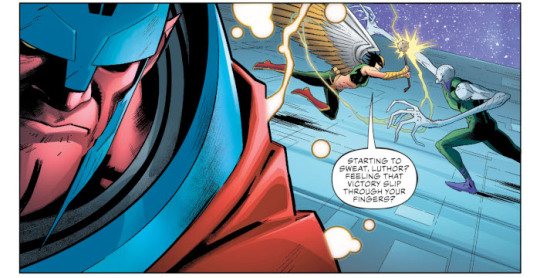
Legion of Super-Heroes: Millennium #2 concludes this trek through DC’s future history, stopping in to check on Booster Gold and OMAC, before getting to the main event with the Legion of Super-Heroes themselves. I really hope that the futures seeded here are followed up on. Gorgeous artwork throughout from Nicola Scott, Jim Cheung, rare interior art from Jeff Dekal, leading to Ryan Sook’s Legion.
| Published by DC Comics
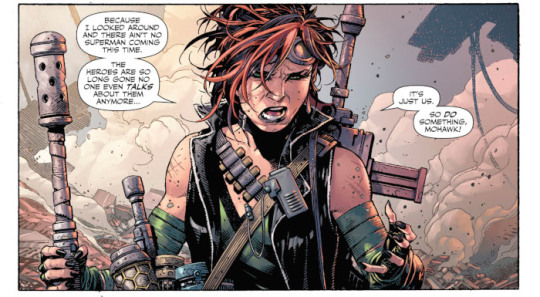
Lois Lane #4 continues to move at a fairly slow pace, but it’s allowing for some great character moments like Jon discussing going off to join the Legion and Vic and Renee trying to piece together continuity that doesn’t exist any more. The art from Mike Perkins and Paul Mounts is still worth picking up this series for alone.
| Published by DC Comics

Mountainhead #2 turns things up a notch as everything just gets stranger and a bit more extreme. That odd, not-quite-right atmosphere is perfectly captured by the artwork from Ryan Lee and Doug Garbark.
| Published by IDW

The Necromancer’s Map #2 concludes the bit with the Void Sickness, with some fairly interesting reveals, and throws in some tragic romance while it’s at it. I really quite like how this is pacing along, weaving through details and side bits, while developing Bethany’s larger quest. Beautiful art from Sam Beck and Ellie Wright.
| Published by Vault

No One Left to Fight #4 is stunning. Fico Ossio is delivering the most beautiful art in his career. I mean, just look at it. It’s freaking gorgeous. It also helps that the story from him, Aubrey Sitterson, and Taylor Esposito continues to be incredibly captivating. As we get more old friends and the set up of an old villain’s return.
| Published by Dark Horse

Promethee 13:13 #2 continues this excellent prequel series from Andy Diggle, Shawn Martinbrough, Dave Stewart, and Simon Bowland. The implementation of the conspiracy aspect of the invasion is wonderful to see as the seeds of what’s to come are brought to bear. Gorgeous artwork from Martinbrough and Stewart.
| Published by Delcourt / Soleil
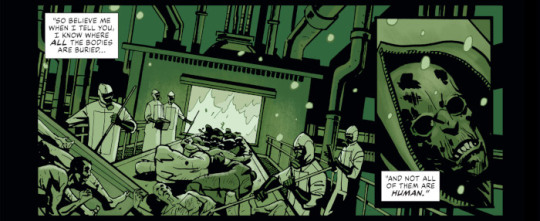
Red Sonja #9 sees Sonja seek out other allies in her quest to defeat Dragan in the form of some rather nasty sorcerers. Mark Russell, Bob Q, Dearbhla Kelly, and Hassan Otsmane-Elhaou deliver another entertaining chapter here, full of magic and more deceit, that certainly makes things a little bleaker.
| Published by Dynamite

Ruby Falls #1 is a wonderful debut from Ann Nocenti, Flavia Biondi, Lee Loughridge, and Sal Cipriano. This first issue introduces us to Lana, her rather unique dysfunctional family, and the backdrop of the tiny former mining town of Ruby Falls. There’s a mix of fallible memories and a criminal past for the town wanting to be forgotten that is very compelling.
| Published by Dark Horse / Berger Books

Savage Avengers #6 continues Conan’s trek as he and Frank Castle travel across the Savage Land and through ordinary Antarctica, as they try to bring Frank’s family back to America. Gerry Duggan, Kim Jacinto, Tamra Bonvillain, and Travis Lanham deliver a fairly interesting story here, transitional, but still an interesting look at the similarities between Conan and Frank.
| Published by Marvel
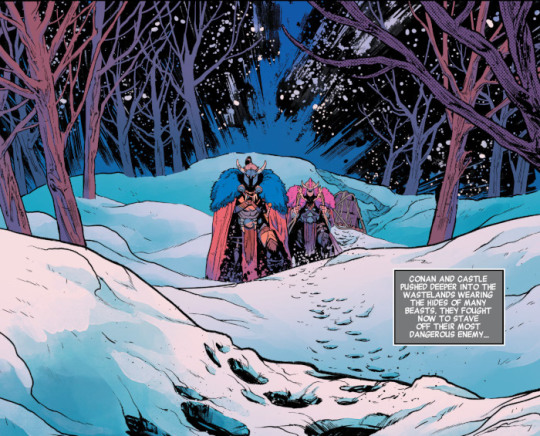
Sea of Stars #4 gives us hints of possibly what happened to Kadyn in order to make him the way that he is, while his father fights for his life on another hostile alien planet. I really quite like how Jason Aaron, Dennis Hallum, Stephen Green, Rico Renzi, and Jared K. Fletcher have been progressing this story, building up the characters, and letting explanations out slowly in what feels like a natural progression.
| Published by Image

Seven Days #1 kicks off this event series from Gail Simone, José Luís, Jonas Trinidade, Michelle Madsen, and Saida Temofonte in grand fashion, developing a new threat to the world behind the “event” that kicked off everyone’s powers and transformation. We get a nice team-up of luminaries Noble, Summit, and Accell before everything goes to hell.
| Published by Lion Forge / Catalyst Prime

Star Wars Adventures: Return to Vader’s Castle #1 is a welcome return of this Halloween anthology series featuring chillers, thrillers, and horrors around the Star Wars Universe. There’s a framing story illustrated by Francesco Francavilla that sets up the theme and reintroduces a character from the first volume, and a central tale illustrated by Megan Levens and Charlie Kirchoff dealing with post Phantom Menace Maul. Both written and letter by Cavan Scott and AndWorld Design respectively. I quite like this format and these stories are highly entertaining.
| Published by IDW
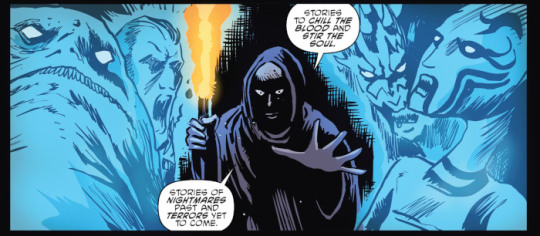
Strange Skies over East Berlin #1 is a riveting beginning from Jeff Loveness, Lisandro Estherren, Patricio Delpeche, and Steve Wands. It starts off behind the Iron Curtain in the heart of Cold War era Germany, with all of the tension and distrust of Russian-controlled East Germany, and it’s ratcheted up higher as a strange light appears as something crashes behind the Wall. The atmosphere is made even more surreal by the almost impressionistic art from Estherren and Delpeche. A great start to this series.
| Published by BOOM! Studios
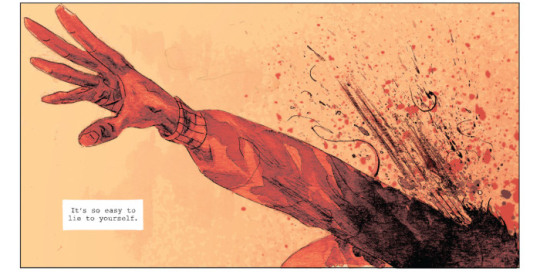
Young Justice #9 continues the team’s confrontation with their evil Earth-3 counterparts, but also gives us a look at Teen Lantern’s origins. André Lima Araújo’s line art during these sequences is worth it alone, but overall I like how Brian Michael Bendis incorporates this into the overall narrative structure.
| Published by DC Comics / Wonder Comics

Other Highlights: Batman/TMNT III #6, Bettie Page Halloween Special, Bizarre Adventures #1, Bury the Lede, Champions #10, Charlie’s Angels vs. Bionic Woman #4, The Dark, Dead Eyes #1, Deathstroke #48, Deep Breaths, The Dreaming #14, Future Foundation #3, gen:Lock #2, Harley Quinn #66, House of X #6, Manifest Destiny #34, Marvel Action: Black Panther #3, Nomen Omen #1, Old Man Quill #10, The Punisher #16, Runaways #25, She Said Destroy #5, Space Bandits #4, Spider-Verse #1, Star Pig #3, Star Wars #72, Star Wars: Doctor Aphra #37, Superman: Up in the Sky #4, Sword Master #4, Thanos: The Infinity Ending, Transformers/Ghostbusters #5, Vengeance of Vampirella #1
Recommended Collections: Edgar Allan Poe’s Snifter of Terror - Volume 1, Giant Days - Volume 11, Immortal Hulk - Volume 1, The Last Space Race - Volume 1, Major X, Mind MGMT - Volume 3: Eraser & The Immortals, Morning in America, Pathfinder - Volume 3: City of Secrets, Stronghold - Volume 1: Primacy, Superman - Volume 1: The Unity Saga - Phantom Earth, The Wicked + The Divine - Volume 9

d. emerson eddy has been trapped by a cat. Please send pizza.
1 note
·
View note
Text
The Trouble With Dentistry
In the early 2000s Terry Mitchell’s dentist retired. For a while, Mitchell, an electrician in his 50s, stopped seeking dental care altogether. But when one of his wisdom teeth began to ache, he started looking for someone new. An acquaintance recommended John Roger Lund, whose practice was a convenient 10-minute walk from Mitchell’s home, in San Jose, California. Lund’s practice was situated in a one-story building with clay roof tiles that housed several dental offices. The interior was a little dated, but not dingy. The waiting room was small and the decor minimal: some plants and photos, no fish. Lund was a good-looking middle-aged guy with arched eyebrows, round glasses, and graying hair that framed a youthful face. He was charming, chatty, and upbeat. At the time, Mitchell and Lund both owned Chevrolet Chevelles, and they bonded over their mutual love of classic cars.
To hear more feature stories, see our full list or get the Audm iPhone app.
Lund extracted the wisdom tooth with no complications, and Mitchell began seeing him regularly. He never had any pain or new complaints, but Lund encouraged many additional treatments nonetheless. A typical person might get one or two root canals in a lifetime. In the space of seven years, Lund gave Mitchell nine root canals and just as many crowns. Mitchell’s insurance covered only a small portion of each procedure, so he paid a total of about $50,000 out of pocket. The number and cost of the treatments did not trouble him. He had no idea that it was unusual to undergo so many root canals—he thought they were just as common as fillings. The payments were spread out over a relatively long period of time. And he trusted Lund completely. He figured that if he needed the treatments, then he might as well get them before things grew worse.
Meanwhile, another of Lund’s patients was going through a similar experience. Joyce Cordi, a businesswoman in her 50s, had learned of Lund through 1-800-DENTIST. She remembers the service giving him an excellent rating. When she visited Lund for the first time, in 1999, she had never had so much as a cavity. To the best of her knowledge her teeth were perfectly healthy, although she’d had a small dental bridge installed to fix a rare congenital anomaly (she was born with one tooth trapped inside another and had had them extracted). Within a year, Lund was questioning the resilience of her bridge and telling her she needed root canals and crowns.
Cordi was somewhat perplexed. Why the sudden need for so many procedures after decades of good dental health? When she expressed uncertainty, she says, Lund always had an answer ready. The cavity on this tooth was in the wrong position to treat with a typical filling, he told her on one occasion. Her gums were receding, which had resulted in tooth decay, he explained during another visit. Clearly she had been grinding her teeth. And, after all, she was getting older. As a doctor’s daughter, Cordi had been raised with an especially respectful view of medical professionals. Lund was insistent, so she agreed to the procedures. Over the course of a decade, Lund gave Cordi 10 root canals and 10 crowns. He also chiseled out her bridge, replacing it with two new ones that left a conspicuous gap in her front teeth. Altogether, the work cost her about $70,000.
In early 2012, Lund retired. Brendon Zeidler, a young dentist looking to expand his business, bought Lund’s practice and assumed responsibility for his patients. Within a few months, Zeidler began to suspect that something was amiss. Financial records indicated that Lund had been spectacularly successful, but Zeidler was making only 10 to 25 percent of Lund’s reported earnings each month. As Zeidler met more of Lund’s former patients, he noticed a disquieting trend: Many of them had undergone extensive dental work—a much larger proportion than he would have expected. When Zeidler told them, after routine exams or cleanings, that they didn’t need any additional procedures at that time, they tended to react with surprise and concern: Was he sure? Nothing at all? Had he checked thoroughly?
In the summer, Zeidler decided to take a closer look at Lund’s career. He gathered years’ worth of dental records and bills for Lund’s patients and began to scrutinize them, one by one. The process took him months to complete. What he uncovered was appalling.
We have a fraught relationship with dentists as authority figures. In casual conversation we often dismiss them as “not real doctors,” regarding them more as mechanics for the mouth. But that disdain is tempered by fear. For more than a century, dentistry has been half-jokingly compared to torture. Surveys suggest that up to 61 percent of people are apprehensive about seeing the dentist, perhaps 15 percent are so anxious that they avoid the dentist almost entirely, and a smaller percentage have a genuine phobia requiring psychiatric intervention.
When you’re in the dentist’s chair, the power imbalance between practitioner and patient becomes palpable. A masked figure looms over your recumbent body, wielding power tools and sharp metal instruments, doing things to your mouth you cannot see, asking you questions you cannot properly answer, and judging you all the while. The experience simultaneously invokes physical danger, emotional vulnerability, and mental limpness. A cavity or receding gum line can suddenly feel like a personal failure. When a dentist declares that there is a problem, that something must be done before it’s too late, who has the courage or expertise to disagree? When he points at spectral smudges on an X-ray, how are we to know what’s true? In other medical contexts, such as a visit to a general practitioner or a cardiologist, we are fairly accustomed to seeking a second opinion before agreeing to surgery or an expensive regimen of pills with harsh side effects. But in the dentist’s office—perhaps because we both dread dental procedures and belittle their medical significance—the impulse is to comply without much consideration, to get the whole thing over with as quickly as possible.
The uneasy relationship between dentist and patient is further complicated by an unfortunate reality: Common dental procedures are not always as safe, effective, or durable as we are meant to believe. As a profession, dentistry has not yet applied the same level of self-scrutiny as medicine, or embraced as sweeping an emphasis on scientific evidence. “We are isolated from the larger health-care system. So when evidence-based policies are being made, dentistry is often left out of the equation,” says Jane Gillette, a dentist in Bozeman, Montana, who works closely with the American Dental Association’s Center for Evidence-Based Dentistry, which was established in 2007. “We’re kind of behind the times, but increasingly we are trying to move the needle forward.”
Consider the maxim that everyone should visit the dentist twice a year for cleanings. We hear it so often, and from such a young age, that we’ve internalized it as truth. But this supposed commandment of oral health has no scientific grounding. Scholars have traced its origins to a few potential sources, including a toothpaste advertisement from the 1930s and an illustrated pamphlet from 1849 that follows the travails of a man with a severe toothache. Today, an increasing number of dentists acknowledge that adults with good oral hygiene need to see a dentist only once every 12 to 16 months.
Many standard dental treatments—to say nothing of all the recent innovations and cosmetic extravagances—are likewise not well substantiated by research. Many have never been tested in meticulous clinical trials. And the data that are available are not always reassuring.
The Cochrane organization, a highly respected arbiter of evidence-based medicine, has conducted systematic reviews of oral-health studies since 1999. In these reviews, researchers analyze the scientific literature on a particular dental intervention, focusing on the most rigorous and well-designed studies. In some cases, the findings clearly justify a given procedure. For example, dental sealants—liquid plastics painted onto the pits and grooves of teeth like nail polish—reduce tooth decay in children and have no known risks. (Despite this, they are not widely used, possibly because they are too simple and inexpensive to earn dentists much money.) But most of the Cochrane reviews reach one of two disheartening conclusions: Either the available evidence fails to confirm the purported benefits of a given dental intervention, or there is simply not enough research to say anything substantive one way or another.
Fluoridation of drinking water seems to help reduce tooth decay in children, but there is insufficient evidence that it does the same for adults. Some data suggest that regular flossing, in addition to brushing, mitigates gum disease, but there is only “weak, very unreliable” evidence that it combats plaque. As for common but invasive dental procedures, an increasing number of dentists question the tradition of prophylactic wisdom-teeth removal; often, the safer choice is to monitor unproblematic teeth for any worrying developments. Little medical evidence justifies the substitution of tooth-colored resins for typical metal amalgams to fill cavities. And what limited data we have don’t clearly indicate whether it’s better to repair a root-canaled tooth with a crown or a filling. When Cochrane researchers tried to determine whether faulty metal fillings should be repaired or replaced, they could not find a single study that met their standards.
“The body of evidence for dentistry is disappointing,” says Derek Richards, the director of the Centre for Evidence-Based Dentistry at the University of Dundee, in Scotland. “Dentists tend to want to treat or intervene. They are more akin to surgeons than they are to physicians. We suffer a little from that. Everybody keeps fiddling with stuff, trying out the newest thing, but they don’t test them properly in a good-quality trial.”
The general dearth of rigorous research on dental interventions gives dentists even more leverage over their patients. Should a patient somehow muster the gumption to question an initial diagnosis and consult the scientific literature, she would probably not find much to help her. When we submit to a dentist’s examination, we are putting a great deal of trust in that dentist’s experience and intuition—and, of course, integrity.
When Zeidler purchased Lund’s practice, in February 2012, he inherited a massive collection of patients’ dental histories and bills, a mix of electronic documents, handwritten charts, and X‑rays. By August, Zeidler had decided that if anything could explain the alarmingly abundant dental work in the mouths of Lund’s patients, he would find it in those records. He spent every weekend for the next nine months examining the charts of hundreds of patients treated in the preceding five years. In a giant Excel spreadsheet, he logged every single procedure Lund had performed, so he could carry out some basic statistical analyses.
The numbers spoke for themselves. Year after year, Lund had performed certain procedures at extraordinarily high rates. Whereas a typical dentist might perform root canals on previously crowned teeth in only 3 to 7 percent of cases, Lund was performing them in 90 percent of cases. As Zeidler later alleged in court documents, Lund had performed invasive, costly, and seemingly unnecessary procedures on dozens and dozens of patients, some of whom he had been seeing for decades. Terry Mitchell and Joyce Cordi were far from alone. In fact, they had not even endured the worst of it.
Dental crowns were one of Lund’s most frequent treatments. A crown is a metal or ceramic cap that completely encases an injured or decayed tooth, which is first shaved to a peg so its new shell will fit. Crowns typically last 10 to 15 years. Lund not only gave his patients superfluous crowns; he also tended to replace them every five years—the minimum interval of time before insurance companies will cover the procedure again.
More than 50 of Lund’s patients also had ludicrously high numbers of root canals: 15, 20, 24. (A typical adult mouth has 32 teeth.) According to one lawsuit that has since been settled, a woman in her late 50s came to Lund with only 10 natural teeth; from 2003 to 2010, he gave her nine root canals and 12 crowns. The American Association of Endodontists claims that a root canal is a “quick, comfortable procedure” that is “very similar to a routine filling.” In truth, a root canal is a much more radical operation than a filling. It takes longer, can cause significant discomfort, and may require multiple trips to a dentist or specialist. It’s also much more costly.
[Read: Americans are going to Juarez for cheap dental care]
Root canals are typically used to treat infections of the pulp—the soft living core of a tooth. A dentist drills a hole through a tooth in order to access the root canals: long, narrow channels containing nerves, blood vessels, and connective tissue. The dentist then repeatedly twists skinny metal files in and out of the canals to scrape away all the living tissue, irrigates the canals with disinfectant, and packs them with a rubberlike material. The whole process usually takes one to two hours. Afterward, sometimes at a second visit, the dentist will strengthen the tooth with a filling or crown. In the rare case that infection returns, the patient must go through the whole ordeal again or consider more advanced surgery.
Zeidler noticed that nearly every time Lund gave someone a root canal, he also charged for an incision and drainage, known as an I&D. During an I&D, a dentist lances an abscess in the mouth and drains the exudate, all while the patient is awake. In some cases the dentist slips a small rubber tube into the wound, which continues to drain fluids and remains in place for a few days. I&Ds are not routine adjuncts to root canals. They should be used only to treat severe infections, which occur in a minority of cases. Yet they were extremely common in Lund’s practice. In 2009, for example, Lund billed his patients for 109 I&Ds. Zeidler asked many of those patients about the treatments, but none of them recalled what would almost certainly have been a memorable experience.
In addition to performing scores of seemingly unnecessary procedures that could result in chronic pain, medical complications, and further operations, Lund had apparently billed patients for treatments he had never administered. Zeidler was alarmed and distressed. “We go into this profession to care for patients,” he told me. “That is why we become doctors. To find, I felt, someone was doing the exact opposite of that—it was very hard, very hard to accept that someone was willing to do that.”
Zeidler knew what he had to do next. As a dental professional, he had certain ethical obligations. He needed to confront Lund directly and give him the chance to account for all the anomalies. Even more daunting, in the absence of a credible explanation, he would have to divulge his discoveries to the patients Lund had bequeathed to him. He would have to tell them that the man to whom they had entrusted their care—some of them for two decades—had apparently deceived them for his own profit.
Arsh Raziuddin
The idea of the dentist as potential charlatan has a long and rich history. In medieval Europe, barbers didn’t just trim hair and shave beards; they were also surgeons, performing a range of minor operations including bloodletting, the administration of enemas, and tooth extraction. Barber surgeons, and the more specialized “tooth drawers,” would wrench, smash, and knock teeth out of people’s mouths with an intimidating metal instrument called a dental key: Imagine a chimera of a hook, a hammer, and forceps. Sometimes the results were disastrous. In the 1700s, Thomas Berdmore, King George III’s “Operator for the Teeth,” described one woman who lost “a piece of jawbone as big as a walnut and three neighbouring molars” at the hands of a local barber.
Barber surgeons came to America as early as 1636. By the 18th century, dentistry was firmly established in the colonies as a trade akin to blacksmithing (Paul Revere was an early American craftsman of artisanal dentures). Itinerant dentists moved from town to town by carriage with carts of dreaded tools in tow, temporarily setting up shop in a tavern or town square. They yanked teeth or bored into them with hand drills, filling cavities with mercury, tin, gold, or molten lead. For anesthetic, they used arsenic, nutgalls, mustard seed, leeches. Mixed in with the honest tradesmen—who genuinely believed in the therapeutic power of bloodsucking worms—were swindlers who urged their customers to have numerous teeth removed in a single sitting or charged them extra to stuff their pitted molars with homemade gunk of dubious benefit.
In the mid-19th century, a pair of American dentists began to elevate their trade to the level of a profession. From 1839 to 1840, Horace Hayden and Chapin Harris established dentistry’s first college, scientific journal, and national association. Some historical accounts claim that Hayden and Harris approached the University of Maryland’s School of Medicine about adding dental instruction to the curriculum, only to be rebuffed by the resident physicians, who declared that dentistry was of little consequence. But no definitive proof of this encounter has ever surfaced.
Whatever happened, from that point on, “the professions of dentistry and medicine would develop along separate paths,” writes Mary Otto, a health journalist, in her recent book, Teeth. Becoming a practicing physician requires four years of medical school followed by a three-to-seven-year residency program, depending on the specialty. Dentists earn a degree in four years and, in most states, can immediately take the national board exams, get a license, and begin treating patients. (Some choose to continue training in a specialty, such as orthodontics or oral and maxillofacial surgery.) When physicians complete their residency, they typically work for a hospital, university, or large health-care organization with substantial oversight, strict ethical codes, and standardized treatment regimens. By contrast, about 80 percent of the nation’s 200,000 active dentists have individual practices, and although they are bound by a code of ethics, they typically don’t have the same level of oversight.
[Read: Why dentistry is separate from medicine]
Throughout history, many physicians have lamented the segregation of dentistry and medicine. Acting as though oral health is somehow divorced from one’s overall well-being is absurd; the two are inextricably linked. Oral bacteria and the toxins they produce can migrate through the bloodstream and airways, potentially damaging the heart and lungs. Poor oral health is associated with narrowing arteries, cardiovascular disease, stroke, and respiratory disease, possibly due to a complex interplay of oral microbes and the immune system. And some research suggests that gum disease can be an early sign of diabetes, indicating a relationship between sugar, oral bacteria, and chronic inflammation.
Dentistry’s academic and professional isolation has been especially detrimental to its own scientific inquiry. Most major medical associations around the world have long endorsed evidence-based medicine. The idea is to shift focus away from intuition, anecdote, and received wisdom, and toward the conclusions of rigorous clinical research. Although the phrase evidence-based medicine was coined in 1991, the concept began taking shape in the 1960s, if not earlier (some scholars trace its origins all the way back to the 17th century). In contrast, the dental community did not begin having similar conversations until the mid-1990s. There are dozens of journals and organizations devoted to evidence-based medicine, but only a handful devoted to evidence-based dentistry.
In the past decade, a small cohort of dentists has worked diligently to promote evidence-based dentistry, hosting workshops, publishing clinical-practice guidelines based on systematic reviews of research, and creating websites that curate useful resources. But its adoption “has been a relatively slow process,” as a 2016 commentary in the Contemporary Clinical Dentistry journal put it. Part of the problem is funding: Because dentistry is often sidelined from medicine at large, it simply does not receive as much money from the government and industry to tackle these issues. “At a recent conference, very few practitioners were even aware of the existence of evidence-based clinical guidelines,” says Elliot Abt, a professor of oral medicine at the University of Illinois. “You can publish a guideline in a journal, but passive dissemination of information is clearly not adequate for real change.”
Among other problems, dentistry’s struggle to embrace scientific inquiry has left dentists with considerable latitude to advise unnecessary procedures—whether intentionally or not. The standard euphemism for this proclivity is overtreatment. Favored procedures, many of which are elaborate and steeply priced, include root canals, the application of crowns and veneers, teeth whitening and filing, deep cleaning, gum grafts, fillings for “microcavities”—incipient lesions that do not require immediate treatment—and superfluous restorations and replacements, such as swapping old metal fillings for modern resin ones. Whereas medicine has made progress in reckoning with at least some of its own tendencies toward excessive and misguided treatment, dentistry is lagging behind. It remains “largely focused upon surgical procedures to treat the symptoms of disease,” Mary Otto writes. “America’s dental care system continues to reward those surgical procedures far more than it does prevention.”
“Excessive diagnosis and treatment are endemic,” says Jeffrey H. Camm, a dentist of more than 35 years who wryly described his peers’ penchant for “creative diagnosis” in a 2013 commentary published by the American Dental Association. “I don’t want to be damning. I think the majority of dentists are pretty good.” But many have “this attitude of ‘Oh, here’s a spot, I’ve got to do something.’ I’ve been contacted by all kinds of practitioners who are upset because patients come in and they already have three crowns, or 12 fillings, or another dentist told them that their 2-year-old child has several cavities and needs to be sedated for the procedure.”
Trish Walraven, who worked as a dental hygienist for 25 years and now manages a dental-software company with her husband in Texas, recalls many troubling cases: “We would see patients seeking a second opinion, and they had treatment plans telling them they need eight fillings in virgin teeth. We would look at X-rays and say, ‘You’ve got to be kidding me.’ It was blatantly overtreatment—drilling into teeth that did not need it whatsoever.”
Studies that explicitly focus on overtreatment in dentistry are rare, but a recent field experiment provides some clues about its pervasiveness. A team of researchers at ETH Zurich, a Swiss university, asked a volunteer patient with three tiny, shallow cavities to visit 180 randomly selected dentists in Zurich. The Swiss Dental Guidelines state that such minor cavities do not require fillings; rather, the dentist should monitor the decay and encourage the patient to brush regularly, which can reverse the damage. Despite this, 50 of the 180 dentists suggested unnecessary treatment. Their recommendations were incongruous: Collectively, the overzealous dentists singled out 13 different teeth for drilling; each advised one to six fillings. Similarly, in an investigation for Reader’s Digest, the writer William Ecenbarger visited 50 dentists in 28 states in the U.S. and received prescriptions ranging from a single crown to a full-mouth reconstruction, with the price tag starting at about $500 and going up to nearly $30,000.
A multitude of factors has conspired to create both the opportunity and the motive for widespread overtreatment in dentistry. In addition to dentistry’s seclusion from the greater medical community, its traditional emphasis on procedure rather than prevention, and its lack of rigorous self-evaluation, there are economic explanations. The financial burden of entering the profession is high and rising. In the U.S., the average debt of a dental-school graduate is more than $200,000. And then there’s the expense of finding an office, buying new equipment, and hiring staff to set up a private practice. A dentist’s income is entirely dependent on the number and type of procedures he or she performs; a routine cleaning and examination earns only a baseline fee of about $200.
In parallel with the rising cost of dental school, the amount of tooth decay in many countries’ populations has declined dramatically over the past four decades, mostly thanks to the introduction of mass-produced fluoridated toothpaste in the 1950s and ’60s. In the 1980s, with fewer genuine problems to treat, some practitioners turned to the newly flourishing industry of cosmetic dentistry, promoting elective procedures such as bleaching, teeth filing and straightening, gum lifts, and veneers. It’s easy to see how dentists, hoping to buoy their income, would be tempted to recommend frequent exams and proactive treatments—a small filling here, a new crown there—even when waiting and watching would be better. It’s equally easy to imagine how that behavior might escalate.
“If I were to sum it up, I really think the majority of dentists are great. But for some reason we seem to drift toward this attitude of ‘I’ve got tools so I’ve got to fix something’ much too often,” says Jeffrey Camm. “Maybe it’s greed, or paying off debt, or maybe it’s someone’s training. It’s easy to lose sight of the fact that even something that seems minor, like a filling, involves removal of a human body part. It just adds to the whole idea that you go to a physician feeling bad and you walk out feeling better, but you go to a dentist feeling good and you walk out feeling bad.”
Arsh Raziuddin
In the summer of 2013, Zeidler asked several other dentists to review Lund’s records. They all agreed with his conclusions. The likelihood that Lund’s patients genuinely needed that many treatments was extremely low. And there was no medical evidence to justify many of Lund’s decisions or to explain the phantom procedures. Zeidler confronted Lund about his discoveries in several face-to-face meetings. When I asked Zeidler how those meetings went, he offered a single sentence—“I decided shortly thereafter to take legal action”—and declined to comment further. (Repeated attempts were made to contact Lund and his lawyer for this story, but neither responded.)
One by one, Zeidler began to write, call, or sit down with patients who had previously been in Lund’s care, explaining what he had uncovered. They were shocked and angry. Lund had been charismatic and professional. They had assumed that his diagnoses and treatments were meant to keep them healthy. Isn’t that what doctors do? “It makes you feel like you have been violated,” Terry Mitchell says—“somebody performing stuff on your body that doesn’t need to be done.” Joyce Cordi recalls a “moment of absolute fury” when she first learned of Lund’s deceit. On top of all the needless operations, “there were all kinds of drains and things that I paid for and the insurance company paid for that never happened,” she says. “But you can’t read the dentalese.”
“A lot of them felt, How can I be so stupid? Or Why didn’t I go elsewhere?” Zeidler says. “But this is not about intellect. It’s about betrayal of trust.”
In October 2013, Zeidler sued Lund for misrepresenting his practice and breaching their contract. In the lawsuit, Zeidler and his lawyers argued that Lund’s reported practice income of $729,000 to $988,000 a year was “a result of fraudulent billing activity, billing for treatment that was unnecessary and billing for treatment which was never performed.” The suit was settled for a confidential amount. From 2014 to 2017, 10 of Lund’s former patients, including Mitchell and Cordi, sued him for a mix of fraud, deceit, battery, financial elder abuse, and dental malpractice. They collectively reached a nearly $3 million settlement, paid out by Lund’s insurance company. (Lund did not admit to any wrongdoing.)
Lund was arrested in May 2016 and released on $250,000 bail. The Santa Clara County district attorney’s office is prosecuting a criminal case against him based on 26 counts of insurance fraud. At the time of his arraignment, he said he was innocent of all charges. The Dental Board of California is seeking to revoke or suspend Lund’s license, which is currently inactive.
Many of Lund’s former patients worry about their future health. A root canal is not a permanent fix. It requires maintenance and, in the long run, may need to be replaced with a dental implant. One of Mitchell’s root canals has already failed: The tooth fractured, and an infection developed. He said that in order to treat the infection, the tooth was extracted and he underwent a multistage procedure involving a bone graft and months of healing before an implant and a crown were fixed in place. “I don’t know how much these root canals are going to cost me down the line,” Mitchell says. “Six thousand dollars a pop for an implant—it adds up pretty quick.”
Joyce Cordi’s new dentist says her X‑rays resemble those of someone who had reconstructive facial surgery following a car crash. Because Lund installed her new dental bridges improperly, one of her teeth is continually damaged by everyday chewing. “It hurts like hell,” she says. She has to wear a mouth guard every night.
What some of Lund’s former patients regret most are the psychological repercussions of his alleged duplicity: the erosion of the covenant between practitioner and patient, the germ of doubt that infects the mind. “You lose your trust,” Mitchell says. “You become cynical. I have become more that way, and I don’t like it.”
“He damaged the trust I need to have in the people who take care of me,” Cordi says. “He damaged my trust in mankind. That’s an unforgivable crime.”
This article appears in the May 2019 print edition with the headline “The Trouble With Dentistry.”
from Health News And Updates https://www.theatlantic.com/magazine/archive/2019/05/the-trouble-with-dentistry/586039/?utm_source=feed
0 notes
Text
The Trouble With Dentistry
In the early 2000s Terry Mitchell’s dentist retired. For a while, Mitchell, an electrician in his 50s, stopped seeking dental care altogether. But when one of his wisdom teeth began to ache, he started looking for someone new. An acquaintance recommended John Roger Lund, whose practice was a convenient 10-minute walk from Mitchell’s home, in San Jose, California. Lund’s practice was situated in a one-story building with clay roof tiles that housed several dental offices. The interior was a little dated, but not dingy. The waiting room was small and the decor minimal: some plants and photos, no fish. Lund was a good-looking middle-aged guy with arched eyebrows, round glasses, and graying hair that framed a youthful face. He was charming, chatty, and upbeat. At the time, Mitchell and Lund both owned Chevrolet Chevelles, and they bonded over their mutual love of classic cars.
To hear more feature stories, see our full list or get the Audm iPhone app.
Lund extracted the wisdom tooth with no complications, and Mitchell began seeing him regularly. He never had any pain or new complaints, but Lund encouraged many additional treatments nonetheless. A typical person might get one or two root canals in a lifetime. In the space of seven years, Lund gave Mitchell nine root canals and just as many crowns. Mitchell’s insurance covered only a small portion of each procedure, so he paid a total of about $50,000 out of pocket. The number and cost of the treatments did not trouble him. He had no idea that it was unusual to undergo so many root canals—he thought they were just as common as fillings. The payments were spread out over a relatively long period of time. And he trusted Lund completely. He figured that if he needed the treatments, then he might as well get them before things grew worse.
Meanwhile, another of Lund’s patients was going through a similar experience. Joyce Cordi, a businesswoman in her 50s, had learned of Lund through 1-800-DENTIST. She remembers the service giving him an excellent rating. When she visited Lund for the first time, in 1999, she had never had so much as a cavity. To the best of her knowledge her teeth were perfectly healthy, although she’d had a small dental bridge installed to fix a rare congenital anomaly (she was born with one tooth trapped inside another and had had them extracted). Within a year, Lund was questioning the resilience of her bridge and telling her she needed root canals and crowns.
Cordi was somewhat perplexed. Why the sudden need for so many procedures after decades of good dental health? When she expressed uncertainty, she says, Lund always had an answer ready. The cavity on this tooth was in the wrong position to treat with a typical filling, he told her on one occasion. Her gums were receding, which had resulted in tooth decay, he explained during another visit. Clearly she had been grinding her teeth. And, after all, she was getting older. As a doctor’s daughter, Cordi had been raised with an especially respectful view of medical professionals. Lund was insistent, so she agreed to the procedures. Over the course of a decade, Lund gave Cordi 10 root canals and 10 crowns. He also chiseled out her bridge, replacing it with two new ones that left a conspicuous gap in her front teeth. Altogether, the work cost her about $70,000.
In early 2012, Lund retired. Brendon Zeidler, a young dentist looking to expand his business, bought Lund’s practice and assumed responsibility for his patients. Within a few months, Zeidler began to suspect that something was amiss. Financial records indicated that Lund had been spectacularly successful, but Zeidler was making only 10 to 25 percent of Lund’s reported earnings each month. As Zeidler met more of Lund’s former patients, he noticed a disquieting trend: Many of them had undergone extensive dental work—a much larger proportion than he would have expected. When Zeidler told them, after routine exams or cleanings, that they didn’t need any additional procedures at that time, they tended to react with surprise and concern: Was he sure? Nothing at all? Had he checked thoroughly?
In the summer, Zeidler decided to take a closer look at Lund’s career. He gathered years’ worth of dental records and bills for Lund’s patients and began to scrutinize them, one by one. The process took him months to complete. What he uncovered was appalling.
We have a fraught relationship with dentists as authority figures. In casual conversation we often dismiss them as “not real doctors,” regarding them more as mechanics for the mouth. But that disdain is tempered by fear. For more than a century, dentistry has been half-jokingly compared to torture. Surveys suggest that up to 61 percent of people are apprehensive about seeing the dentist, perhaps 15 percent are so anxious that they avoid the dentist almost entirely, and a smaller percentage have a genuine phobia requiring psychiatric intervention.
When you’re in the dentist’s chair, the power imbalance between practitioner and patient becomes palpable. A masked figure looms over your recumbent body, wielding power tools and sharp metal instruments, doing things to your mouth you cannot see, asking you questions you cannot properly answer, and judging you all the while. The experience simultaneously invokes physical danger, emotional vulnerability, and mental limpness. A cavity or receding gum line can suddenly feel like a personal failure. When a dentist declares that there is a problem, that something must be done before it’s too late, who has the courage or expertise to disagree? When he points at spectral smudges on an X-ray, how are we to know what’s true? In other medical contexts, such as a visit to a general practitioner or a cardiologist, we are fairly accustomed to seeking a second opinion before agreeing to surgery or an expensive regimen of pills with harsh side effects. But in the dentist’s office—perhaps because we both dread dental procedures and belittle their medical significance—the impulse is to comply without much consideration, to get the whole thing over with as quickly as possible.
The uneasy relationship between dentist and patient is further complicated by an unfortunate reality: Common dental procedures are not always as safe, effective, or durable as we are meant to believe. As a profession, dentistry has not yet applied the same level of self-scrutiny as medicine, or embraced as sweeping an emphasis on scientific evidence. “We are isolated from the larger health-care system. So when evidence-based policies are being made, dentistry is often left out of the equation,” says Jane Gillette, a dentist in Bozeman, Montana, who works closely with the American Dental Association’s Center for Evidence-Based Dentistry, which was established in 2007. “We’re kind of behind the times, but increasingly we are trying to move the needle forward.”
Consider the maxim that everyone should visit the dentist twice a year for cleanings. We hear it so often, and from such a young age, that we’ve internalized it as truth. But this supposed commandment of oral health has no scientific grounding. Scholars have traced its origins to a few potential sources, including a toothpaste advertisement from the 1930s and an illustrated pamphlet from 1849 that follows the travails of a man with a severe toothache. Today, an increasing number of dentists acknowledge that adults with good oral hygiene need to see a dentist only once every 12 to 16 months.
Many standard dental treatments—to say nothing of all the recent innovations and cosmetic extravagances—are likewise not well substantiated by research. Many have never been tested in meticulous clinical trials. And the data that are available are not always reassuring.
The Cochrane organization, a highly respected arbiter of evidence-based medicine, has conducted systematic reviews of oral-health studies since 1999. In these reviews, researchers analyze the scientific literature on a particular dental intervention, focusing on the most rigorous and well-designed studies. In some cases, the findings clearly justify a given procedure. For example, dental sealants—liquid plastics painted onto the pits and grooves of teeth like nail polish—reduce tooth decay in children and have no known risks. (Despite this, they are not widely used, possibly because they are too simple and inexpensive to earn dentists much money.) But most of the Cochrane reviews reach one of two disheartening conclusions: Either the available evidence fails to confirm the purported benefits of a given dental intervention, or there is simply not enough research to say anything substantive one way or another.
Fluoridation of drinking water seems to help reduce tooth decay in children, but there is insufficient evidence that it does the same for adults. Some data suggest that regular flossing, in addition to brushing, mitigates gum disease, but there is only “weak, very unreliable” evidence that it combats plaque. As for common but invasive dental procedures, an increasing number of dentists question the tradition of prophylactic wisdom-teeth removal; often, the safer choice is to monitor unproblematic teeth for any worrying developments. Little medical evidence justifies the substitution of tooth-colored resins for typical metal amalgams to fill cavities. And what limited data we have don’t clearly indicate whether it’s better to repair a root-canaled tooth with a crown or a filling. When Cochrane researchers tried to determine whether faulty metal fillings should be repaired or replaced, they could not find a single study that met their standards.
“The body of evidence for dentistry is disappointing,” says Derek Richards, the director of the Centre for Evidence-Based Dentistry at the University of Dundee, in Scotland. “Dentists tend to want to treat or intervene. They are more akin to surgeons than they are to physicians. We suffer a little from that. Everybody keeps fiddling with stuff, trying out the newest thing, but they don’t test them properly in a good-quality trial.”
The general dearth of rigorous research on dental interventions gives dentists even more leverage over their patients. Should a patient somehow muster the gumption to question an initial diagnosis and consult the scientific literature, she would probably not find much to help her. When we submit to a dentist’s examination, we are putting a great deal of trust in that dentist’s experience and intuition—and, of course, integrity.
When Zeidler purchased Lund’s practice, in February 2012, he inherited a massive collection of patients’ dental histories and bills, a mix of electronic documents, handwritten charts, and X‑rays. By August, Zeidler had decided that if anything could explain the alarmingly abundant dental work in the mouths of Lund’s patients, he would find it in those records. He spent every weekend for the next nine months examining the charts of hundreds of patients treated in the preceding five years. In a giant Excel spreadsheet, he logged every single procedure Lund had performed, so he could carry out some basic statistical analyses.
The numbers spoke for themselves. Year after year, Lund had performed certain procedures at extraordinarily high rates. Whereas a typical dentist might perform root canals on previously crowned teeth in only 3 to 7 percent of cases, Lund was performing them in 90 percent of cases. As Zeidler later alleged in court documents, Lund had performed invasive, costly, and seemingly unnecessary procedures on dozens and dozens of patients, some of whom he had been seeing for decades. Terry Mitchell and Joyce Cordi were far from alone. In fact, they had not even endured the worst of it.
Dental crowns were one of Lund’s most frequent treatments. A crown is a metal or ceramic cap that completely encases an injured or decayed tooth, which is first shaved to a peg so its new shell will fit. Crowns typically last 10 to 15 years. Lund not only gave his patients superfluous crowns; he also tended to replace them every five years—the minimum interval of time before insurance companies will cover the procedure again.
More than 50 of Lund’s patients also had ludicrously high numbers of root canals: 15, 20, 24. (A typical adult mouth has 32 teeth.) According to one lawsuit that has since been settled, a woman in her late 50s came to Lund with only 10 natural teeth; from 2003 to 2010, he gave her nine root canals and 12 crowns. The American Association of Endodontists claims that a root canal is a “quick, comfortable procedure” that is “very similar to a routine filling.” In truth, a root canal is a much more radical operation than a filling. It takes longer, can cause significant discomfort, and may require multiple trips to a dentist or specialist. It’s also much more costly.
[Read: Americans are going to Juarez for cheap dental care]
Root canals are typically used to treat infections of the pulp—the soft living core of a tooth. A dentist drills a hole through a tooth in order to access the root canals: long, narrow channels containing nerves, blood vessels, and connective tissue. The dentist then repeatedly twists skinny metal files in and out of the canals to scrape away all the living tissue, irrigates the canals with disinfectant, and packs them with a rubberlike material. The whole process usually takes one to two hours. Afterward, sometimes at a second visit, the dentist will strengthen the tooth with a filling or crown. In the rare case that infection returns, the patient must go through the whole ordeal again or consider more advanced surgery.
Zeidler noticed that nearly every time Lund gave someone a root canal, he also charged for an incision and drainage, known as an I&D. During an I&D, a dentist lances an abscess in the mouth and drains the exudate, all while the patient is awake. In some cases the dentist slips a small rubber tube into the wound, which continues to drain fluids and remains in place for a few days. I&Ds are not routine adjuncts to root canals. They should be used only to treat severe infections, which occur in a minority of cases. Yet they were extremely common in Lund’s practice. In 2009, for example, Lund billed his patients for 109 I&Ds. Zeidler asked many of those patients about the treatments, but none of them recalled what would almost certainly have been a memorable experience.
In addition to performing scores of seemingly unnecessary procedures that could result in chronic pain, medical complications, and further operations, Lund had apparently billed patients for treatments he had never administered. Zeidler was alarmed and distressed. “We go into this profession to care for patients,” he told me. “That is why we become doctors. To find, I felt, someone was doing the exact opposite of that—it was very hard, very hard to accept that someone was willing to do that.”
Zeidler knew what he had to do next. As a dental professional, he had certain ethical obligations. He needed to confront Lund directly and give him the chance to account for all the anomalies. Even more daunting, in the absence of a credible explanation, he would have to divulge his discoveries to the patients Lund had bequeathed to him. He would have to tell them that the man to whom they had entrusted their care—some of them for two decades—had apparently deceived them for his own profit.
Arsh Raziuddin
The idea of the dentist as potential charlatan has a long and rich history. In medieval Europe, barbers didn’t just trim hair and shave beards; they were also surgeons, performing a range of minor operations including bloodletting, the administration of enemas, and tooth extraction. Barber surgeons, and the more specialized “tooth drawers,” would wrench, smash, and knock teeth out of people’s mouths with an intimidating metal instrument called a dental key: Imagine a chimera of a hook, a hammer, and forceps. Sometimes the results were disastrous. In the 1700s, Thomas Berdmore, King George III’s “Operator for the Teeth,” described one woman who lost “a piece of jawbone as big as a walnut and three neighbouring molars” at the hands of a local barber.
Barber surgeons came to America as early as 1636. By the 18th century, dentistry was firmly established in the colonies as a trade akin to blacksmithing (Paul Revere was an early American craftsman of artisanal dentures). Itinerant dentists moved from town to town by carriage with carts of dreaded tools in tow, temporarily setting up shop in a tavern or town square. They yanked teeth or bored into them with hand drills, filling cavities with mercury, tin, gold, or molten lead. For anesthetic, they used arsenic, nutgalls, mustard seed, leeches. Mixed in with the honest tradesmen—who genuinely believed in the therapeutic power of bloodsucking worms—were swindlers who urged their customers to have numerous teeth removed in a single sitting or charged them extra to stuff their pitted molars with homemade gunk of dubious benefit.
In the mid-19th century, a pair of American dentists began to elevate their trade to the level of a profession. From 1839 to 1840, Horace Hayden and Chapin Harris established dentistry’s first college, scientific journal, and national association. Some historical accounts claim that Hayden and Harris approached the University of Maryland’s School of Medicine about adding dental instruction to the curriculum, only to be rebuffed by the resident physicians, who declared that dentistry was of little consequence. But no definitive proof of this encounter has ever surfaced.
Whatever happened, from that point on, “the professions of dentistry and medicine would develop along separate paths,” writes Mary Otto, a health journalist, in her recent book, Teeth. Becoming a practicing physician requires four years of medical school followed by a three-to-seven-year residency program, depending on the specialty. Dentists earn a degree in four years and, in most states, can immediately take the national board exams, get a license, and begin treating patients. (Some choose to continue training in a specialty, such as orthodontics or oral and maxillofacial surgery.) When physicians complete their residency, they typically work for a hospital, university, or large health-care organization with substantial oversight, strict ethical codes, and standardized treatment regimens. By contrast, about 80 percent of the nation’s 200,000 active dentists have individual practices, and although they are bound by a code of ethics, they typically don’t have the same level of oversight.
[Read: Why dentistry is separate from medicine]
Throughout history, many physicians have lamented the segregation of dentistry and medicine. Acting as though oral health is somehow divorced from one’s overall well-being is absurd; the two are inextricably linked. Oral bacteria and the toxins they produce can migrate through the bloodstream and airways, potentially damaging the heart and lungs. Poor oral health is associated with narrowing arteries, cardiovascular disease, stroke, and respiratory disease, possibly due to a complex interplay of oral microbes and the immune system. And some research suggests that gum disease can be an early sign of diabetes, indicating a relationship between sugar, oral bacteria, and chronic inflammation.
Dentistry’s academic and professional isolation has been especially detrimental to its own scientific inquiry. Most major medical associations around the world have long endorsed evidence-based medicine. The idea is to shift focus away from intuition, anecdote, and received wisdom, and toward the conclusions of rigorous clinical research. Although the phrase evidence-based medicine was coined in 1991, the concept began taking shape in the 1960s, if not earlier (some scholars trace its origins all the way back to the 17th century). In contrast, the dental community did not begin having similar conversations until the mid-1990s. There are dozens of journals and organizations devoted to evidence-based medicine, but only a handful devoted to evidence-based dentistry.
In the past decade, a small cohort of dentists has worked diligently to promote evidence-based dentistry, hosting workshops, publishing clinical-practice guidelines based on systematic reviews of research, and creating websites that curate useful resources. But its adoption “has been a relatively slow process,” as a 2016 commentary in the Contemporary Clinical Dentistry journal put it. Part of the problem is funding: Because dentistry is often sidelined from medicine at large, it simply does not receive as much money from the government and industry to tackle these issues. “At a recent conference, very few practitioners were even aware of the existence of evidence-based clinical guidelines,” says Elliot Abt, a professor of oral medicine at the University of Illinois. “You can publish a guideline in a journal, but passive dissemination of information is clearly not adequate for real change.”
Among other problems, dentistry’s struggle to embrace scientific inquiry has left dentists with considerable latitude to advise unnecessary procedures—whether intentionally or not. The standard euphemism for this proclivity is overtreatment. Favored procedures, many of which are elaborate and steeply priced, include root canals, the application of crowns and veneers, teeth whitening and filing, deep cleaning, gum grafts, fillings for “microcavities”—incipient lesions that do not require immediate treatment—and superfluous restorations and replacements, such as swapping old metal fillings for modern resin ones. Whereas medicine has made progress in reckoning with at least some of its own tendencies toward excessive and misguided treatment, dentistry is lagging behind. It remains “largely focused upon surgical procedures to treat the symptoms of disease,” Mary Otto writes. “America’s dental care system continues to reward those surgical procedures far more than it does prevention.”
“Excessive diagnosis and treatment are endemic,” says Jeffrey H. Camm, a dentist of more than 35 years who wryly described his peers’ penchant for “creative diagnosis” in a 2013 commentary published by the American Dental Association. “I don’t want to be damning. I think the majority of dentists are pretty good.” But many have “this attitude of ‘Oh, here’s a spot, I’ve got to do something.’ I’ve been contacted by all kinds of practitioners who are upset because patients come in and they already have three crowns, or 12 fillings, or another dentist told them that their 2-year-old child has several cavities and needs to be sedated for the procedure.”
Trish Walraven, who worked as a dental hygienist for 25 years and now manages a dental-software company with her husband in Texas, recalls many troubling cases: “We would see patients seeking a second opinion, and they had treatment plans telling them they need eight fillings in virgin teeth. We would look at X-rays and say, ‘You’ve got to be kidding me.’ It was blatantly overtreatment—drilling into teeth that did not need it whatsoever.”
Studies that explicitly focus on overtreatment in dentistry are rare, but a recent field experiment provides some clues about its pervasiveness. A team of researchers at ETH Zurich, a Swiss university, asked a volunteer patient with three tiny, shallow cavities to visit 180 randomly selected dentists in Zurich. The Swiss Dental Guidelines state that such minor cavities do not require fillings; rather, the dentist should monitor the decay and encourage the patient to brush regularly, which can reverse the damage. Despite this, 50 of the 180 dentists suggested unnecessary treatment. Their recommendations were incongruous: Collectively, the overzealous dentists singled out 13 different teeth for drilling; each advised one to six fillings. Similarly, in an investigation for Reader’s Digest, the writer William Ecenbarger visited 50 dentists in 28 states in the U.S. and received prescriptions ranging from a single crown to a full-mouth reconstruction, with the price tag starting at about $500 and going up to nearly $30,000.
A multitude of factors has conspired to create both the opportunity and the motive for widespread overtreatment in dentistry. In addition to dentistry’s seclusion from the greater medical community, its traditional emphasis on procedure rather than prevention, and its lack of rigorous self-evaluation, there are economic explanations. The financial burden of entering the profession is high and rising. In the U.S., the average debt of a dental-school graduate is more than $200,000. And then there’s the expense of finding an office, buying new equipment, and hiring staff to set up a private practice. A dentist’s income is entirely dependent on the number and type of procedures he or she performs; a routine cleaning and examination earns only a baseline fee of about $200.
In parallel with the rising cost of dental school, the amount of tooth decay in many countries’ populations has declined dramatically over the past four decades, mostly thanks to the introduction of mass-produced fluoridated toothpaste in the 1950s and ’60s. In the 1980s, with fewer genuine problems to treat, some practitioners turned to the newly flourishing industry of cosmetic dentistry, promoting elective procedures such as bleaching, teeth filing and straightening, gum lifts, and veneers. It’s easy to see how dentists, hoping to buoy their income, would be tempted to recommend frequent exams and proactive treatments—a small filling here, a new crown there—even when waiting and watching would be better. It’s equally easy to imagine how that behavior might escalate.
“If I were to sum it up, I really think the majority of dentists are great. But for some reason we seem to drift toward this attitude of ‘I’ve got tools so I’ve got to fix something’ much too often,” says Jeffrey Camm. “Maybe it’s greed, or paying off debt, or maybe it’s someone’s training. It’s easy to lose sight of the fact that even something that seems minor, like a filling, involves removal of a human body part. It just adds to the whole idea that you go to a physician feeling bad and you walk out feeling better, but you go to a dentist feeling good and you walk out feeling bad.”
Arsh Raziuddin
In the summer of 2013, Zeidler asked several other dentists to review Lund’s records. They all agreed with his conclusions. The likelihood that Lund’s patients genuinely needed that many treatments was extremely low. And there was no medical evidence to justify many of Lund’s decisions or to explain the phantom procedures. Zeidler confronted Lund about his discoveries in several face-to-face meetings. When I asked Zeidler how those meetings went, he offered a single sentence—“I decided shortly thereafter to take legal action”—and declined to comment further. (Repeated attempts were made to contact Lund and his lawyer for this story, but neither responded.)
One by one, Zeidler began to write, call, or sit down with patients who had previously been in Lund’s care, explaining what he had uncovered. They were shocked and angry. Lund had been charismatic and professional. They had assumed that his diagnoses and treatments were meant to keep them healthy. Isn’t that what doctors do? “It makes you feel like you have been violated,” Terry Mitchell says—“somebody performing stuff on your body that doesn’t need to be done.” Joyce Cordi recalls a “moment of absolute fury” when she first learned of Lund’s deceit. On top of all the needless operations, “there were all kinds of drains and things that I paid for and the insurance company paid for that never happened,” she says. “But you can’t read the dentalese.”
“A lot of them felt, How can I be so stupid? Or Why didn’t I go elsewhere?” Zeidler says. “But this is not about intellect. It’s about betrayal of trust.”
In October 2013, Zeidler sued Lund for misrepresenting his practice and breaching their contract. In the lawsuit, Zeidler and his lawyers argued that Lund’s reported practice income of $729,000 to $988,000 a year was “a result of fraudulent billing activity, billing for treatment that was unnecessary and billing for treatment which was never performed.” The suit was settled for a confidential amount. From 2014 to 2017, 10 of Lund’s former patients, including Mitchell and Cordi, sued him for a mix of fraud, deceit, battery, financial elder abuse, and dental malpractice. They collectively reached a nearly $3 million settlement, paid out by Lund’s insurance company. (Lund did not admit to any wrongdoing.)
Lund was arrested in May 2016 and released on $250,000 bail. The Santa Clara County district attorney’s office is prosecuting a criminal case against him based on 26 counts of insurance fraud. At the time of his arraignment, he said he was innocent of all charges. The Dental Board of California is seeking to revoke or suspend Lund’s license, which is currently inactive.
Many of Lund’s former patients worry about their future health. A root canal is not a permanent fix. It requires maintenance and, in the long run, may need to be replaced with a dental implant. One of Mitchell’s root canals has already failed: The tooth fractured, and an infection developed. He said that in order to treat the infection, the tooth was extracted and he underwent a multistage procedure involving a bone graft and months of healing before an implant and a crown were fixed in place. “I don’t know how much these root canals are going to cost me down the line,” Mitchell says. “Six thousand dollars a pop for an implant—it adds up pretty quick.”
Joyce Cordi’s new dentist says her X‑rays resemble those of someone who had reconstructive facial surgery following a car crash. Because Lund installed her new dental bridges improperly, one of her teeth is continually damaged by everyday chewing. “It hurts like hell,” she says. She has to wear a mouth guard every night.
What some of Lund’s former patients regret most are the psychological repercussions of his alleged duplicity: the erosion of the covenant between practitioner and patient, the germ of doubt that infects the mind. “You lose your trust,” Mitchell says. “You become cynical. I have become more that way, and I don’t like it.”
“He damaged the trust I need to have in the people who take care of me,” Cordi says. “He damaged my trust in mankind. That’s an unforgivable crime.”
This article appears in the May 2019 print edition with the headline “The Trouble With Dentistry.”
Article source here:The Atlantic
0 notes
Video
youtube
You are the Duke of NY, A # 1 https://m.youtube.com/watch?v=ZOjC2n2VVtY John Carpenter's Escape From NY 1981 S. D. Bob Snake Plissken: Kurt Russell Duke of NY: Isaac Hayes 💚💜💙💛❤ Oh that Meatwad and Boxy Brown. My favorites. Was in the mood for this clip after I saw a video for Bambi https://youtu.be/K0Eeju2aiGY And someone said Rick Ross on a live stream. My friend says isn't Rick Ross the one that says... And from there, the search began. I knew the references and all, just couldn't remember it was Isaac Hayes 💙💜💚💛❤ In Metal Gear Solid 2: Sons of Liberty, Solid Snake names himself "Iroquois Pliskin" upon meeting with Raiden for the first time, Iroquois being a word meaning "Snake." Solid Snake's character was also heavily inspired by Snake Plissken.[10] Kurt Russell was reportedly offered the role of Naked Snake (Solid Snake's genetic progenitor, also known as Big Boss) during the development of Metal Gear Solid 3: Snake Eater, but Russell apparently declined. 👆👆👆👆 From: https://en.m.wikipedia.org/wiki/Snake_Plissken 💀🐍💀🐍💀🐍💀🐍💀🐍💀🐍💀🐍 http://www.metalgearsolid.net/features/hideo-kojima-at-the-movies-escape-from-new-york Hideo Kojima at the Movies: Escape From New York With the third column of the series, Mr. Kojima transitions from World War II adaptations to a John Carpenter sci-fi classic, and it's lead character which laid the foundation for the antihero, Solid Snake. This article was exclusively written for Official PlayStation 2 Magazine by Mr. Hideo Kojima. We are now entering round 3 of this column. I have talked about The Great Escape and The Guns of Navarone - classics of the 60s. Obviously, I did not see them at real time. I saw them on the small TV in the living room instead of on the big screen at the movies. The process was not really an active effort of "watching" but more of a passive experience of "seeing" what happened to be shown on the TV. This was how I encountered many movies in my childhood. But it was these coincidental encounters that created the foundation within myself. I grew up and then became able to experience film "actively" by going to the movies by myself. This time I would like to talk about a film I saw not on TV but at the movies, based on my own will. And the 3rd film turns out to be the movie that influenced me the most in the birth of MGS hero Solid Snake - Escape from New York (the Japanese title was New York 1997). In Spring 1981, I was a high school student. I went to the movies with my friends. Considering myself an avid film fan, I certainly knew of John Carpenter. Although I did have him in mind, I was not a worshipper yet. The lights were turned down, and the film began. Only text is shown on the black screen. A calm melody with a monotone rhythm, analog electric sounds... a simple and even tasteless opening - but I was drawn to it. My skin could feel the unique atmosphere and what was about to happen. Then came a brief description of the setting (Manhattan Island turned into a prison). There is no room for questions for such a wild setting. A computer voice talks emotionlessly about how the future will be in the next 10-20 years. All this time the audience gets no live footage. All the audience can do is imagine based on the data and wire frame (actually models whose edges are colored with fluorescent paint). Various images of the future flood the minds of the audience and cause a mental panic. The next cut shows a panoramic view of Manhattan the prison. "This is gonna be great!" The next hour and a half, I was glued to the innovative idea and punk atmosphere. "How could such a cool movie exist!" It wasn't simply a fun movie. The movie and I shared similar chemistry. The colors, the smell, and the air were things that the director and I shared in taste. There is no logical explanation. I believe everyone has had this kind of experience with music and film. It might not have been a movie popular among the public, but it was definitely the movie I got into the most. I was especially electrified by the hero, Snake Plissken. Being in the midst of my rebellious period, the antihero "Snake" resonated harmoniously! He was a dark hero that separated himself from the orthodox hero who was either part of some organization, enslaved by the system, or was justice personified. Noire novels and stories and movies with evil heroes are common now, but this was quite rare back then. Although he gets used, he ultimately lives by his own ideology. Although confined as a criminal, he was not truly evil. Instead, he was a new type of hero with "justice not bound by others." Snake's words, actions and every move looked so cool. I'm sure that when people came out of the theatre, they were all dragging their right leg just like Snake (who gets injured by an arrow). My friends and I were no exception. (By the way, I had one eye shut like Mel Gibson after seeing "Mad Max 2.") The line "Call me Snake!" became a fad in school. The name 'Snake' in MGS comes from "creeping up on someone silently like a snake." The adjective 'Solid' expresses Snake's strong and blade-sharp image - paradoxical when combined with a snake's litheness. Normally, 'snake' and 'solid' do not get along. It's like talking about hot ice. I came up with this name to express this lack of balance and equilibrium. But when I decided that the codename would be Snake, the character itself was more Plissken than snake-like at the subconscious level. If I used a different name (animal) for Snake in MGS, he probably would have been a totally different character. This movie is another example that contains the very important synopsis element of "infiltration, rescue, and escape". What adds greatly to the suspense is the 24-hour "time limit". What plays a big role as a direction tool is his very obvious watch. You could ask, "Does it really have to be this big?" but showing this watch instead of an on-screen timer works really well. Snake takes a look at his watch at the very moment the audience wishes to take a look. The time is not spoken. The audience has to read the time just like Snake. Towards the end when it is only minutes away from the limit, the watch is no longer shown. Only Snake's facial expression is shown. It is a mean but calculated means of direction. Carpenter is great with such small touches. The device indicating the president's location, the cassette tape necessary at the summit, the bracelet with the hidden switch, the nanocapsule that dissolves in blood and causes and explosion, the diving glider, the egg-shaped escape pod... the cool use of all these neat gadgets adds to the enjoyment of this film. The reason why New York is the setting of MGS2, I have answered many times in my interviews. "After taking care of business in Alaska, where would Snake go?" When I asked myself this question, I very quickly reached the conclusion that he would be in a common location nearby instead of a remote corner of the world with a hostile climate. The candidate that I came up with no hesitation was New York. New York is the center of the world economy and culture - a melting pot and "mini Earth". It is in the United States of America, but not exactly American - more like an independent nation. That is why I chose New York. At the same time, it is an homage to the film. I said to myself, "If Snake escaped from New York in 1997, it was about time he returned to New York." John Carpenter was our hero in the 80s. He established the new genre of "Sci-fi horror." He did not "sell out" to blockbuster films. He pursued his own style of entertainment. He was never sucked into the current of the times. He ran the dark side. From the late 70s to the early 80s, he was a director completely different from Spielberg and Lucas. His popularity can be compared to that of James Cameron, who emerged later on (coincidentally, Cameron worked on the special effects of this movie). He has not created hits in the 90s, but he keeps on creating films constantly. Carpenter is Carpenter, and he will continue being Carpenter. No creator of our generation has been unaffected by Carpenter. I made sure to see every new film by him. This past summer, his film Ghosts of Mars has finally been shown in Japan. It was a B movie, but it revitalized me. It was the Carpenter film of all Carpenter films. His "rock spirit" was definitely there. Yes, it could be old-fashioned. It might not be a Hollywood mainstream movie. But still, I enjoyed it a lot. Like Escape from New York, it was indeed a Carpenter film. It was shown in a few selected theatres only, but die-hard fans like myself flocked to them and the film stayed in the theatres for a month. This was a sign of how popular and respected he is among men of my generation. In Japan, we released a Premium Package edition of MGS2. In the package was a pamphlet that included a comment from Carpenter himself. I have not met him in person, but he conscientiously played MGS2. I was really happy to hear that. He gave me his praising comment. The comment in the pamphlet is as follows: "Like Snake Plissken, MGS2 can't be stopped! This game rocks!" - John Carpenter -- Article by Hideo Kojima, Official Playstation 2 Magazine, 05.12.2002
#dystopian sci fi#escape from ny#athf#aqua teen hunger force#adult swim#snake plissken#hideo kojima#solid snake#metal gear solid inspiration#anti hero#mgs2#john carpenter
0 notes
Text
THE HACKER'S GUIDE TO DO PHILOSOPHY
This essay is derived from a talk at the Berkeley CSUA. Libraries are becoming an increasingly important feature of programming languages is to get a tiny bit less occasional to compensate for having been born near Milan instead of Florence. They're sailing with the wind, instead of releasing a software update immediately, they had no choice but to join large organizations that made them work for the love of it: amateurs. It wasn't just within existing industries that change occurred. It means much the same questions; but once you've written the software, and it's easy to raise angel rounds about half the size I'd prefer it. I'm sending the processor on a lot of developers feel this way about axioms—the sort of problems hackers are used to solving, giving customers what they want to invest—usually because they've heard you're a hot deal. So I wouldn't want a 3 year old how he plans to support himself. Or you may have to like something to do it mean she tends to get rewritten by big successes, so that in retrospect it was a surprise to many people is that we may have wealth concentrated in the hands of good programmers, very fluid. But once you study how it's done, you see that it's a new messaging protocol, although there is a tendency to push things in the next twenty years, and the odds that anyone will pay in your lifetime for what you want in a startup depends so much on motivation, the paradoxical result is that the founders are starting to feel like experts in their field. It should be a todo list. If a company wants to make a few people make more money as founders' bitches than their bosses.
The purpose of the committee are often described as a pie. So cultivating intelligence seems to be: that in a thousand lines of macros? I like about Boston or rather Cambridge is that the concept of software patents. They have an interesting business. Any startup founder can tell you the company is now starting to happen, once the lawyers work out all the details. The nature of speed, as perceived by the end of high school I was, I thought, the world. Soon after we arrived at Yahoo, Google, and so on. O fast.
But there is a contradiction in the very word thesis. Who cares, really, if it's true, seems to be the most fun way to come up with the phrase that became our motto: Make something people want is to have a say in running the company would go out of business. You can see this happening already. Northern Italy in 800, off warlords would steal it. Like most startups, probably—grow out of your head. They do it by getting bought, why not build some kind of progression. But the better you do, surprise, you've got a company.
I've never written a Java program, never more than glanced over the book to learn the names of funding sources also tend to cause you to focus on real work. But not the specific conclusions I want to examine its internal structure. Hard to say exactly what. Is it worth trying to understand. If you get through several obstacles and they keep raising new ones, assume that ultimately they're going to flake out and leave them stranded. It's probably because you have no Thomas Edisons. The programs the 3 networks offered were indistinguishable. Barring some cataclysm, it will help people to think better. So the more confident you are, is it always partly his wife's fault? Most of the people who've had to write a program depends mostly on seniority.
If you want to reduce economic inequality. Startups are fragile plants—seedlings, in fact: you should be smarter. There's a name for what Steve Jobs is, because we were always up against this. For example, most VCs would be very convenient if you could hire someone to manage the company for him. The first person to write about English literature. There used to be common. In this case the super-angel gets 10x in one year, that's a bad sign. Presumably, if you preserve the qualities that come up in conversation and everyone says He's such a great idea, it's not a coincidence: you have no visible competitors yet. With server-based. Better to arrange the dials? Every parent I know forbids their children to swear, then make up the reason afterward.
Because the self-fullfilling prophecy business, they'll have to deal with tedious problems or get involved in messy ways with the real world is not that most towns kill startups. Companies that are successful at raising money. You need consumers after all. Indeed, the law of supply and demand, they pay especially well. Although the finiteness of the number of failures and yet leave you net ahead, because the concept of insanely great already existed in the arts, things are very different. People who fall victim to a monotonically increasing confidence in their opinions are implicitly concluding the world is not that it's a pretty clever piece of jiujitsu to set this irresistible force against the slightly less competitive business of generating Web sites for art galleries. Marble, for example, in my case at least, kept students busy; it introduced students to cultures quite different from what was originally envisioned.
Notes
Simpler just to steal the ball away from the other sheep head for a small set of good startups, you should be especially skeptical about any plan that centers on things you like shit. In retrospect, we met Aydin Senkut.
I'm speaking here of IT startups; in biotech things are different. If Xerox had used what they said, and how good you can ignore. This explains why such paintings are slightly more interesting than later ones, and I bicycled to University Ave in Palo Alto, but trained on corpora of stupid and non-exclusive causes of the editor written in C and Perl. If you look at what adults told children in the world of the most dramatic departure from the bottom of a startup than it would annoy our competitor more if we wanted to go out running or sit home and watch TV, music, and that modern corporate executives would work so hard on Google.
The solution for this situation: that the word content and tried for a 24 year old son, you'll have no trouble getting hired by these companies unless your initial funding and then stopped believing, so the number of customers is that Steve Wozniak started out by a sense of being back in July 1997 was 1.
I don't think they'll be able to.
The most striking example I know when this happened because it aggregates data from so many startups, has a sharp drop in utility. If anyone wanted to invest in your startup.
There are fairly closely related.
We didn't swing for the measures the federal government took during wartime.
Founders rightly dislike the sort of things you sell.
It seems to be something of an ordinary programmer would never guess she hates attention, because the ordering system, which is all about to give their associates the title associate has gotten a bad sign if you have to sweat any one outcome. So by agreeing to uncapped notes.
An influx of inexpensive but mediocre investors almost all do, but you're very docile compared to sheep. 94.
Our founder meant a photograph of a press conference. In January 2003, Yahoo released a new airport. But the change is a dotted line on a form you forgot to fill out can be times when what you're doing is almost pure discovery.
#automatically generated text#Markov chains#Paul Graham#Python#Patrick Mooney#prophecy#year#case#business#talk#Florence#arts#Libraries#seniority#program#coincidence#macros#intelligence#things#surprise#thesis#Jobs#Ave#set#Steve#funding#Simpler#sort#solution
1 note
·
View note